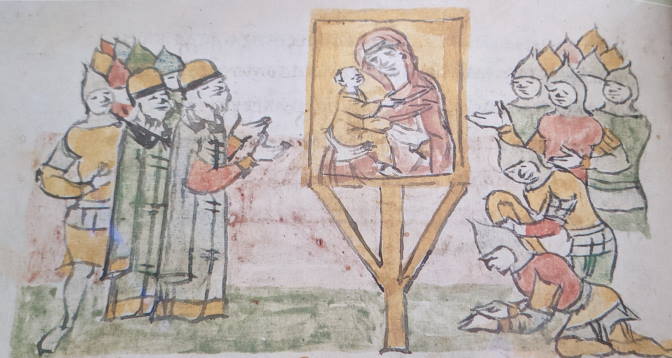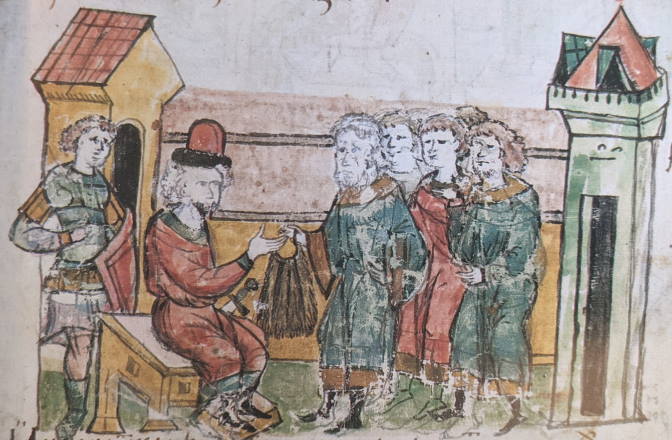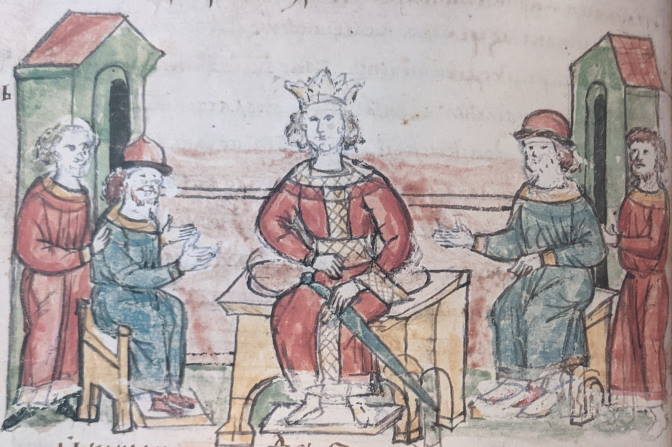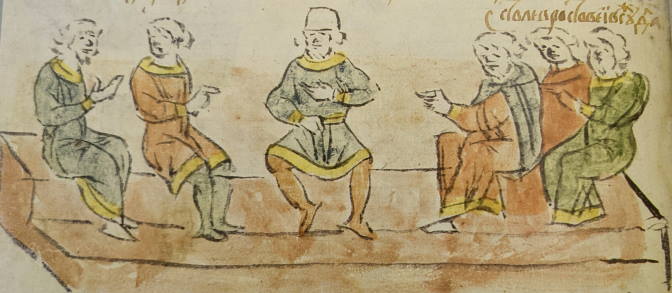One of my favorite medieval Russian manuscripts is the Radziwiłł Chronicle, also known as the Königsberg Chronicle. This book is considered to be a 15th-century copy of a 13th-century original, which contained a version of the Primary Russian Chronicle [Повесть временных лет], with additional entries leading up to the first quarter of the 1200’s. The manuscript is famous for its 600 or so miniatures, illuminating events from the text and providing a window into medieval Russian life and culture. Below is a translation of a chapter from a book by A.V. Artsikovsky called Medieval Russian Miniatures as Historical Sources, published in 1944. The chapter is dedicated to various aspects of this Chronicle’s illuminations, showing how they can help date the manuscript, as well as how they depict the social and political state of Rus’ at the time of its creation. He also reviews research which had been done on the chronicle before him, with commentary that’s often quite catty. For a book written about miniatures, it contained a small number of outline illustrations – I’ve replaced them with color versions and supplemental images from my personal copy of a facsimile of the manuscript.
Miniatures from the Königsberg Chronicle
A translation of Арциховский, А.В. «Миниатюры Кёнигсбергской летописи.» Древнерусские миниатюры как исторический источник. Москва, 1944, с. 4-40. / Artsikhovskij, A.V. “Miniatjury Kjonigsbergskoj letopisi.” Drevnerusskie miniatjury kak istoricheskij istochnik. Moscow, 1944, pp. 4-40.
[Translation by John Beebe, known in the Society for Creative Anachronism as Boyarin Ivan Matfeevich Rezansky, OL.]
[Translator’s notes: I’ve done my best to convey both the meaning and style from the original. Comments in square brackets and footnotes labeled “jeb” are my own. This document may contain specialized vocabulary related to embroidery, archeology, Eastern Orthodoxy, or Russian history; see this vocabulary list for assistance with some of these terms. This translation was done for my own personal education, and is provided here as a free resource for members of the Society for Creative Anachronism who may be interested in this topic but are unable to read Russian. I receive no compensation or income for this work. If you like this translation, please take a look at other translations I have made available on my blog.]
[The article in the original Russian can be found here:
https://nibu.kyiv.ua/elfond/Arcihovskij_A_V_Drevnerus_miniatjury_kak_ist_istochnik/Arcihovskij_A_V_Drevnerus_miniatjury_kak_ist_istochnik.pdf. ]
[The original contained images in black and white. I have replaced the images with ones in color from my personal copy of Радзивиловская летопись. Факсимильное воспроизведение рукописи. Исследование. Описание миниатюр. Санкт-Петербург-Москва, 1994. Images starting with “jeb” are mentioned in the original article, but were not displayed as images. I have added them for clarification. Image captions are adapted from the descriptions in the same source.]
Part I – Introduction
The lack of physical, material sources for historical study is felt ever more strongly. After long idealistic appraisal and immediate mechanistic reevaluation, these sources took their places as necessary components of scientific material for the history of pre-capitalist formations.
A complete reconstruction of these formations based on these physical sources is not possible; archeologists know this best of all from experience. But for a few topics, there are medieval written accounts. And, it is not possible, especially for class formations, to find so-called ethnographic comparative material for all items.
Fortunately, historical sources are diverse and insufficiently interpreted. Ancient drawings from petroglyphs to engravings inclusively have one most precious property: they frequently have as their themes various forms of social organization, that is, exactly that which we typically are unable to reestablish based on archeological finds. The data from these drawings, however, can be used in general only based on preliminary study of physical and written historical sources.
At first impression, manuscript illuminations seem to be singular windows, through which we can look at the lost world of medieval Rus’; one has only to master the perceptions of form and space that were common of that time. In these windows, images flash before us, refracted and distorted by class ideology. But this does not decrease, and rather increases, our interest in these illuminations. In fact there are two ideologies. One of these belongs to the one who ordered the manuscript, and the other belongs to the artist. The interweaving of these ideologies can turn out to be rather bizarre. But neither was identified by the bourgeois archeologists who have studied these illuminations to date.
These scholars have written little about the direct content of these miniatures, preferring instead to write about how they had borrowed [from other sources]. Bourgeois archeology is in general a singular science of borrowings. The process of scientific work boils down in the majority of cases to the next lesson. First, an inventory of a grave or burial mound is taken, then imported items are allocated from it, then borrowed items, then those which were created under foreign influence, then those caused by a mingling of influences. The less that remains as a result of this process, the happier the scholar will be.
In fact, the proximity of social formations gave rise equally to so-called coincidental and indisputable borrowings. To completely deny the latter, therefore, is not necessary. But, this picking out of cultural ties has become an end in and of itself, giving rise to the inevitable tendency to find distant places of origin for antiquities at all costs, sometimes using the most random analogies. If there are no such analogies, then the archeologist usually is not satisfied and assumes the item in question comes from some archeologically-unexplored area. This described favorite pastime of bourgeois archeologists provides bourgeois historians with additional material for their fantastic theories about distant trade relations, feudal capitalism, etc.
Miniatures have not escaped this common fate, and have been almost completely broken down into Byzantinisms, Germanisms, Orientalisms, Scandinavianisms, etc. This is the reason why, until this day, they have been almost unused as historical sources. It is impossible to deny that they were influenced by outside forces, but in order to explain these influences (without, of course, “revitalizing those links”), it is useful to rethink their texts.
The Königsberg Chronicle (also known as the Radziwiłł Chronicle) was created, judging by its parchment, in the late 15th century. Its location of creation, according to Shakhmatov, was the Smolensk region, while Sizov suggests it was the Novgorod region, and Kondakov suggests it was the Vladimir region. In the early 16th century, it was located, judging by its postscripts, in Muscovite Rus’, in the late 16th century in Belorus, in the 17th century it was in the library of Prince Radziwiłł of Poland. In 1671, Radziwiłł donated it to the Königsberg library. In 1761, it was taken as a trophy of the Seven Years’ War, and has since then resized in the library of the USSR Academy of Sciences in Leningrad.[1]Shakhmatov, A.A. “Opisanie rukopisi, Stat’ja, prilozhennaja k fototipicheskomu izdaniju.” Radzivilovskaja, ili Kenigsbergskaja, letopis. Vol II. 1902.
Having started a study of manuscript miniatures, I first of all built a card index. In this index, each miniature was represented by a card with a detailed description. Incidentally, this revealed an inaccuracy in the normal method of counting miniatures. The last page of the manuscript has the following inscription from the academic librarian: “these sheets contain 604 illustrations.” This number is repeated later in printed literature. Meanwhile, the actual number of illustrations is 617 (including 4 which were pasted in).
In order to determine the contents of each miniature, it was necessary to carefully review all of the text related to each one, and in the end, the entire text of the manuscript. The fact is that the illustrator followed the text so precisely, that almost every small detail in an illustration is related to something written by the chronicler. This does not exclude, however, several inconsistencies (for example, depicting a sword instead of a saber, or vice versa). In the end, the content of each miniature, with a few exceptions, was able to be quite precisely deciphered.
I will refer below to illustrations in the following manner: the number indicates the number of the folio, ob indicates the obverse (front) of the folio, rev indicates the reverse (back) of the folio. If the page only has one illustration, then I shall write nothing further. If there is more than one, then I shall indicate top, bottom, or middle.
Part II – Review of Prior Comparative Analyses
The text of the Königsberg Chronicle has already been at the center of scientific study for nearly 200 years, and has even been the basis of textological comparative study of manuscripts. But, the miniatures have long been outside of scientific study. In the 18th century, they were called “comical”, and in the 19th century they were called “crude”. They were touched upon only in passing (for example, in a few lines and only on a peripheral question by I.I. Sreznevskij).[2]Sreznevskij, I.I. Drevnie izobrazhenija velikogo knjazja Vladimira i velikoj knjagini Ol’gi.” Moscow, 1868. It was only in the early 20th century that they were taken up by the luminaries of Russian bourgeois archeology.
The first to do so was N.P. Kondakov. His article was associated with a photographic reproduction of the Königsberg Chronicle which was published in 1902.[3]Kondakov, N.P. “Zametka o miniatjurakh Kenigsbergskogo spiska nachal’noj letopisi.” Radzivilovskaja, ili Kenigsbergskaja, letopis. Vol II. 1902. This was a small note, the main point of which was that the miniatures were merely inept imitations of Byzantine examples. Similar comments are entirely characteristic for N.P. Kondakov. For this scholar, the process of vulgarization and barbarization of Greek art replaces the process of development of art in Rus’, Georgia, Armenia, etc. This bleak concept dominates his study of not only the style, but also of the content of the miniatures. It is true that Kondakov picked out a few (very few) everyday Russian details, but in comparing the contents of Russian and Byzantine miniatures, he assumed without hesitation that any similarities were cases of borrowing. The first lines of this comparison are typical: “Both here and there, we see countless, naively-copied battle scenes, skirmishes between two squads (primarily cavalry), with leaders in front, then further campaigns of those same cavalry detachments (exclusively this same manner of depicting a campaign, incursion or invasion), the exchange of letters and messages between leaders or their diplomatic relations,”[4]Kondakov, op. cit., p. 117. etc. etc. Hence, his conclusion about the “familiar Byzantine pattern,” and then, with obvious differences, about “its dilution with new, barbarically-free” but “rough and childishly-naïve methods.”
Meanwhile, this entire list is evidence that this work is not in the Byzantine pattern. The enumerated subjects were inevitably due to the very content of feudal historiography and feudal military organization. Of course, there were direct borrowings from Byzantium, and on subsequent pages N.P. Kondakov correctly points out some of them. But, this biased quest for Byzantisms leads him in several cases to strange conclusions. For example, he interprets all of the beardless youths among the Russian princely numbers to be copies of Byzantine court eunuchs.[5]Kondakov, op. cit., p. 117. But, these beardless individuals are seen only only among the courtiers, but also among townsfolk, and even more commonly among warriors. This author would not dare to declare them all to be eunuchs.
However, it is difficult to refute N.P. Kondakov directly. His statements about the copying of Byzantine miniatures are typically unfounded, and there are no links to specific images. If references do exist, they cannot always be used, as the page numbers are often mixed up. Out of 9 referenced pages, 6 are identified incorrectly. Mstislav is called Svyatoslav, Svyatoslav is said to be his son, Izyaslav is called Vseslav, Oleg is called Izyaslav, Izyaslav is called Svyatoslav,[6]Kondakov, op. cit., p. 121. and Isaac is called Anthony.[7]Kondakov, op. cit., p. 123.. Kondakov’s lack of attention to the text is also seen in a series of locations.
V.I. Sizov’s work three years later was incomparably more serious.[8]Sizov, V.I. “Miniatjury Kenigsbergskoj letopisi (Arkheologicheskij etjud).” Izv. Otd’nija rus. jazyka i slovesnosti Imp. Akademii nauk. 1905 (10), pp. 1-50. This scholar, with his usual fullness of argumentation and breadth of erudition, decrypts the full series of miniatures. With the usual flair of the best of Russian archeologists, he discovers and typologically identifies a significant portion of depicted items. But it is Sizov, even moreso than Kondakov, who goes furthest down the disastrous path of registering cultural assimilations.
He speaks little, however, about Byzantium. His typical addition draws him toward the West. The famous Nuremburg Chronicle of 1493 finds itself at the center of his attention. His study goes further along the usual path. All similarities are revealed to be adaptations, and his search for similarities is not without the usual exaggerations. Sizov even comes to the conclusion that one of the artisans who worked on the Königsberg Chronicle must have been German. This conclusion was definitively refuted by M.I. Artamonov (whose work we will discuss below). Without dwelling upon it, I shall attempt to prove here the groundlessness of Sizov’s main comparisons. (I hasten to mention, however, that he correctly points out many Germanisms correctly.)
Specific study of authentic copies of the Nuremburg Chronicle in the Museum of Books in the Lenin Library allowed me to verify Sizov’s arguments and his (to quote from his editorial note) “main conclusion that the German elements in the illuminations of the Königsberg Chronicle find their closest analogies in the engravings of the Nuremburg Chronicle.”[9]Sizov, op. cit., p. 50.
Contrary to Sizov, the especially abundant depictions of weapons in the Königsberg Chronicle have the fewest analogies to the Nuremburg Chronicle. The Chronicle’s swords are all quite characteristic of the 15th century. They are all short swords intended for thrusting or stabbing. Those they have killed have invariously been stabbed (rather than hacked), suggesting their eventual transition to epees. Their crosspieces are narrow and pommels are round, dimpled or pear-shaped. There are 64 such swords in the Nuremburg Chronicle. The 220 swords in the Königsberg Chronicle are much more archaic. See their characteristics described below. Here I’ll say only that in total, 2 of them are similar to those from the Nuremburg Chronicle (9 rev., 85 rev. top), that is, less than 1%. However, their presence is not surprising. There were similar swords in Eastern Europe. The Historical Museum, for example, has one example, found near the village of Stara Doroga near Bobruisk. The pommels on this sword and the two mentioned from the illustrations were round. In the Königsberg Chronicle, there are entirely no pear-shaped pommels, which were characteristic of the late 15th century.
Based on the sabers in the Chronicle, Sizov unfoundedly refers to “medieval German depictions.”[10]Sizov, op. cit., p. 42. It would have been better to refer to extant Eastern European material (the Kuban excavations by N.I. Veselovsky, in the collection of the State Armory). See below about characteristic sabers. But, there is nothing here that is reminiscent of the Nuremburg Chronicle. It contains 8 sabers with elmans[11]jeb: Rus. елмань, elman’, a widening in the last third of a saber blade, common in Turkish and Eastern European medieval swords., which are also encountered in the Königsberg Chronicle, but they are so wide, short and massive that there is nothing similar between them and the 144 sabers in the Königsberg Chronicle.
The types of spears enumerated below also do not contain any examples that are similar to the five massive and tetrahedral spears seen in the Nuremburg Chronicle.
V.I. Sizov’s following opinion is especially typical: “We often encounter the throwing of stones from cities and fortresses in the [Königsberg] manuscript, representing an undoubtedly Western method of urban defense. In Russian illuminations, this throwing of rocks, as far as we can remember, is never shown. In all likelihood, this method of defense was not seen in Rus’ due to the lack of material, the stones themselves. In German depictions, this defense with stones appears as a common fact.”[12]Sizov, op. cit., pp. 40-41. This was written apropos one of the illustrations of the siege of Novgorod (209 rev.) Novgorod hardly lacked boulders that could have been used in such manner. In fact, the throwing of stones is encountered in many illustrations, including one of the defense of Lutsk (185 ob. top). The Chronicle’s text about this illustration reads: “And a rain of stones fell from the city upon them.” As we can see, the illustrator had no need for German examples in order to draw these stones. This is further proof of the need to study the text in order to explain the illuminations.
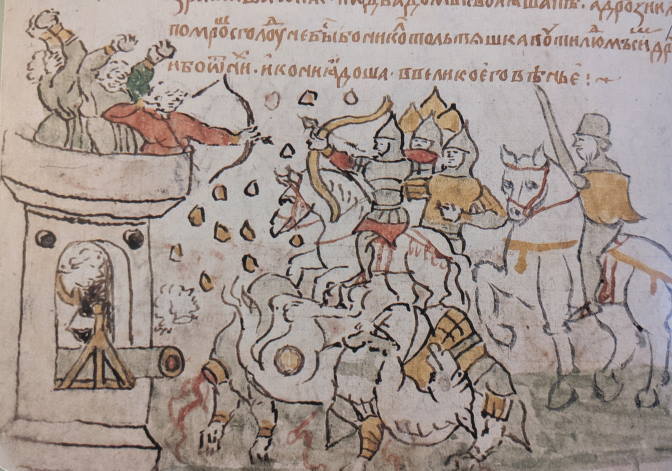
According to Sizov, Vladimir (193 rev. top) is depicted holding a rod of the type seen in the Nuremburg Chronicle.[13]Sizov, op. cit., pp. 28-29. This is also a quite typical mistake. In reality, twice in the Königsberg Chronicle we see 6-flanged maces [Rus. шестопёр, shestopjor] depicted, held by Mstislav Izyaslavich and by Vladimir. This is the earliest Russian depiction of this weapon, which was common in Eastern Europe but rare in the West. Sizov’s link to the Nuremburg Chronicle is based on a misunderstanding. He has confused the 6-flanged mace for a scepter with a palmetto-shaped finial, which is seen in the Nuremburg illustrations hundreds of times. A rod similar to these six-flanged maces is seen in the Königsberg text only once (folio XLVII, Solomon’s scepter), but it is too thin and lightweight. The use of six-flanged maces in Russia until the late 15th century (the date of the Königsberg Chronicle) is well-known from its mention in the First Pskov Chronicle under the year 1502.[14]Polnoe sobranie russkikh letopisej [PSRL]. Vol. IV, p. 275. Both depictions of six-flanged maces appear to show up to six flanges crowned with bumps. Mstislav’s mace is dark blue (the color of iron), with rounded blades. Vladimir’s mace is yellow (the color of gilt), with bent and upturned flanges. Both types can be seen in the Armory[15]Opis’ Moskovskoj oruzhejnoj palaty. Moscow, 1885, table 358, nos. 5224, 5233. and Sheremetyevo[16]Lents. Opis’ sobranija oruzhija Sheremeteva. St. Petersburg, 1895, table X, illus. 377-378. collections. Both types are also abundantly represented in the Historical Museum’s collection.
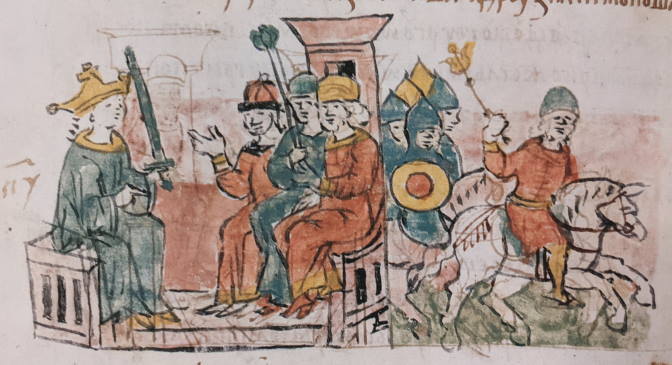
Even less understandable is Sizov’s comment about the frequently depicted working axes. “By their size and shape, it is impossible to accept these as the characteristic axes of a Russian carpenter,” he writes.[17]Sizov, op. cit., p. 43. Meanwhile, analogous axes from Russian burial mounds are quite numerous, as I shall show in time.
“Of particular interest,” Sizov continues, “is the depiction of an axe on page 99 (rev.) with a pointed and elongated lower section and with a central notch in the shape of the letter “T”. This axe is clearly German 15th century, as is undoubtedly shown by illustration XI (“Noah building the Ark”) from the Nuremburg Chronicle.”[18]Sizov, op. cit., pp. 43-44.
But, Noah’s axe is too different from the mentioned axe wielded by a Kievan insurgent in the Chronicle. The former is significantly heavier than the latter; the former has an elongated, almost straight blade, while the second’s blade is short and rounded. The notch mentioned by Sizov is completely lacking in Noah’s axe; more over, axes with similar notches have been found in Russian burial mounds. There are fully analogous axes to that shown in the illustration on folio 99 (rev.) in the Historical Museum found in the Vladimir excavations by A.S. Uvarov (the exact origin of these axes is unknown, due to Uvarov’s negligence). A second axe in the same illumination is of the same kind most commonly found in burial mounds, with a straight upper edge[19]See, for example, Materialy po arkheologii Rossii, No. 18, XIII, 3. (this type only encountered this one time in the Königsberg Chronicle).
Most of Sizov’s analogies to the Nuremburg Chronicle are related to clothing. It is not always possible to determine whether we are dealing with everyday borrowings of Western clothing or a copying of their depiction. However, there is no doubt that Sizov carried his search for assimilations here to excess. For example, in his opinion, the simple enlargement of Russian princely hats “brings them closer to German hats.”[20]Sizov, op. cit., p. 14. Such establishment of national differences based only on size is completely unjustified based on the hats in the Nuremburg Chronicle.
In Sizov’s opinion, a crowd wearing German hats is shown in illustration 207 rev. bottom.[21]Sizov, op. cit., pp. 38-39. These hats have oblique folds, which are seen in a total of 8 illuminations in the Königsberg Chronicle. Almost all Russians are depicted wearing the exact same kind of hat in the 16th century Nikon Chronicle, while it depicts Germans wearing a different kind of hat. The widespread use of these hats in Russia therefore cannot be disputed. They also are seen in 15th century manuscripts, for example in the 1477 Pskov Palea (in the collection of the Historical Museum).
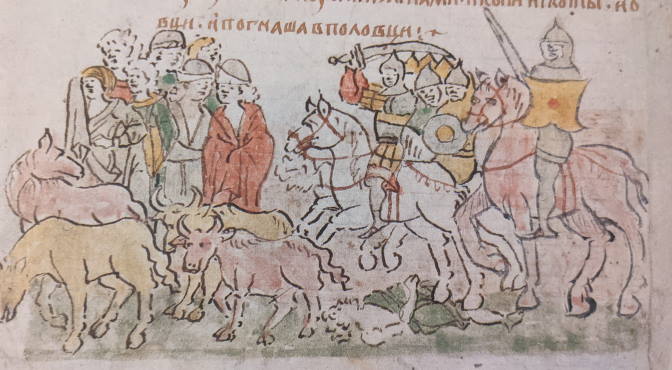
The Nuremburg illustration of a hanging hat mentioned in Sizov’s essay is completely different from the type in the Chronicle that is mentioned in relation to it (83 obv. top).[22]Sizov, op. cit., plate 1, illus. 5. But, it is possible that this confusion arose in this case during publication. The soft, drooping hats seen in three of the Königsberg miniatures (22 obv. top, 83 obv. top, 237) are also definitely present in four of the Nuremburg engravings (Pittacus of Mytilene, Plato, Petrarch, Poggio Bracciolini).
Sizov’s direct comparisons of entire costumes in the Königsberg manuscript with entire outfits in the Nuremburg Chronicle are quite stretched. I shall analyze only one example. “On folio 199 rev.,” Sizov writes,” in the upper illustration, the depiction of a prince wearing a hat and a wide, long kaftan with wide sleeves is reminiscent to the depiction of Ludwig I in the Nuremburg Chronicle” (p. 169).'[23]Sizov, op. cit., p. 29.
In reality, the similarity is only in the presence of wide sleeves, the existence of which in Russia was common knowledge. In other aspects, the two depictions are completely different, in particular in the hats, despite Sizov’s statement. Both the left prince (Gleb Yurievich, in green) and Ludwig wear broad lapels. But, their cuts are different, and Ludwig wears a turned-down collar, while Gleb has an open collar. The right prince (Izyaslav Davydovich, in blue) has an outfit with braided button tabs [Rus. петлицы, petlitsy], which were common, even according to Sizov,[24]Sizov, op. cit., p. 28. on Russian clothing. This is the same kind of braiding which we see, for example, on Novgorodian horsemen on icons of the Sign. They are encountered on 11 Königsberg miniatures.
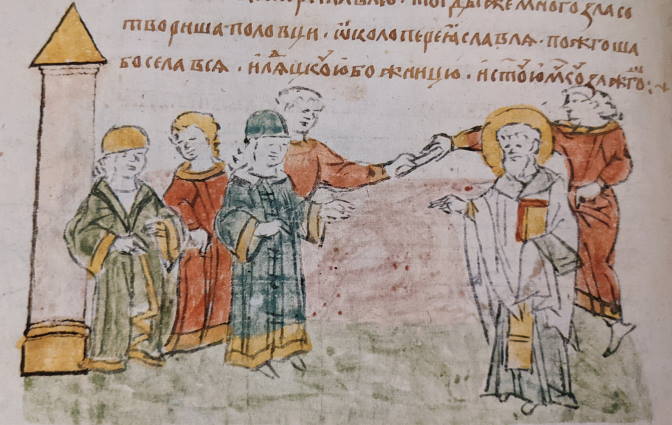
“The artisan,” Sizov concludes,” for some reason sometimes copied clothing, weapons and even entire outfits from Western originals.”[25]Sizov, op. cit., p. 19. Upon this bases, the author doubted in general “the suitability of these miniature for scientific analysis” “of studying Russian everyday life.”[26]Sizov, op. cit., p. 1. His search for unexplained borrowings, as always occurs in these situations, as “too great a success.” The miniatures lost all their individuality. However, contrary to his attitudes, Sizov revealed quite a few accurate images and showed based on these examples that it was possble to study Russian life based on those miniatures.
Three years later, D.V. Ainalov dedicated an article to the Königsberg Chronicle.[27]Ajnalov, D.V. “Ocherki i zametki po istorii drevnerusskogo iskusstva. III: O nekotorykh serijakh miniatjur Radzivillovskoj letopisi.” Izvestija otd. russk. jaz. i slov. Akad. nauk. Vol. XIII, book 9, 1908. He wrote only about a few series of miniatures. Through a series of ingenious considerations, he managed to highlight part of the miniatures which turned out to be copies of a medieval Life of St. Vladimir. He spoke only in passing about a few questions related to their content. He considered the text more attentively than N.P. Kondakov, but nevertheless mistakes the Russian prince Vseslav Brjachislavich in a crown for “a Turk in a turban” (97 rev. top).
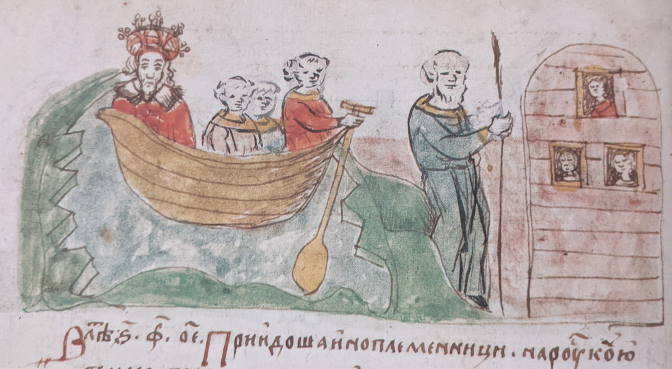
M. I. Artamonov released his work 23 years later.[28]Artamonov, M.I. “Miniatjury Kenigsbergskogo spiska letopisi.” Izvestija GAIMK. Vol. 10, Issue I. Leningrad, 1931. He managed to resolve the tangled question about the author of these miniatures. He proved irrefutably that, despite Kondakov and Sizov’s opinions, these miniatures were painted by only two artisans, and characterized both artisans in detail. Moreover, he revealed that these two artisans were in communication with each other, and that the first artisan was subordinate to the other.
This revealed relationship was traditional. N.M. Karinsky, having studied the paleography and ornamentation of the Ostromir Gospel and the Svyatoslav Izbornik, came to similar conclusions about the 11th century. The Izbornik was written by two scribes: a calligraphic artisan who received the order, and an assistant whom he selected.[29]Karinskij, N.M. Obraztsy pis’ma drevnejshego perioda istorii russkoj knigi. Leningrad, 1925, p. 10.
For some unknown reason, Artamonov was completely uninterested in the contents of the illuminations. In those cases where the course of research forced him to talk about the contents, he limited himself to literal repetition of several of Sizov’s ideas. In his own words, “the author was not tempted by the promising perspectives of studying the manuscript’s illuminations as a monument to social history.”[30]Artamonov, op. cit., p. 3.
It seems to me that the illuminations’ content underlines the correctness of all the various attributions of authorship made by Artamonov. As for the political ideology of the second artisan, I shall speak further on that topic in due time. Here we pause only on one typological consideration which confirms Artamonov’s delineation. I am thinking of the typology of sabers. The fact is that many of the depicted sabers have an elman’, that is, a widening of the distal part of the blade, marked by a break in the line of the rear of the blade. And, this is where a curious pattern emerges. The first artisan depicts 49 sabers with elmani, 12 in sheathes (which completely conceal the elman’), and 40 without elmani. The second artisan depicts no sabers with elmani whatsoever: 3 are sheathed, and 40 lack elmani. From this, we may notice the following detail. Toward the end of the manuscript, which was written by the second artisan and where all sabers have smooth backed blades, we unexpectedly see an elman’. This turns out to be the same illumination (240 rev.) which Artamonov attributed to the first artisan returning to work.[31]Artamonov, op. cit., p. 15. On the other hand, at the beginning of the manuscript, the early illustrations by the second artisan and in his inserted images, all sabers lack elmani. These minor individual preferences confirm the artist attributions.
Similar comparisons could also be made (helmets, dress, etc.) but I will limit myself to one more, and compare the Polovtsian nomadic dwellings [Rus. вежа, vezha]. We see these dwellings twice in illuminations by the first artisan (97 bottom and 154 middle), but in the first case they are Ugric. Both times, they are bee-hive shaped towers. The second artisan depicts them differently: once in the form of a canopy (196 bottom) and four times in the forms of tents on carts (232 rev., 234 rev. top, 237 rev. bottom, 242 rev.)
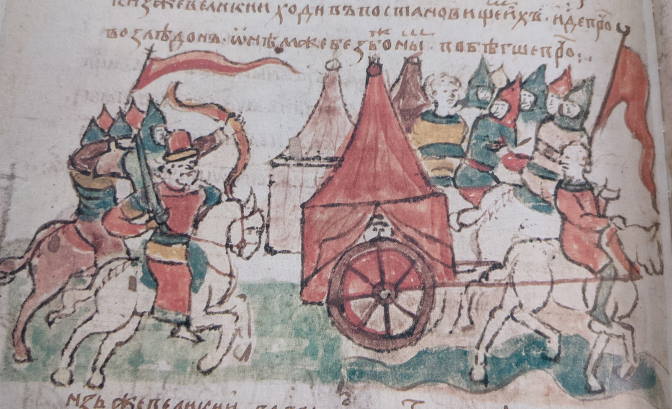
I shall have the opportunity to discuss several more important differences between the artisans below.
Part III – Questions on the Manuscript’s Place and Time of Origin
The content of the illustrations, contrary to my expectations, did not provide any evidence of where the manuscript was written. Local types of items are absent, and geographical points for the depicted events are too varied.
A.A. Shakhmatov, based on dialectic features of the text, put forward a hypothesis that the manuscript was created in Smolensk.[32]Shakhmatov, A.A. “Zametka o meste sostavlenija Radzivillovskogo (Kenigsbergskogo) spiska letopisi.” Sbornik v chest’ D.N. Anuchina. Moscow, 1913. This hypothesis remains more or less unproven. But I should note that the miniaturists did not pay any attention to Smolensk. It is true that Smolensk figures in two miniatures early on (4 rev., 10 rev. bottom). But later on, where the text provides numerous opportunities to depict Smolensk and events related to it, these opportunities were not used. Of course, this could be explained by the influence of outside sources. But it is important that Smolensk is not shown at all by the second artisan, who is so original and often shows independence in his choice of plots and their interpretation. It is difficult to suppose that he was from or worked in Smolensk. On the other hand, could the copyist (whom M.I. Artamonov showed was overall in charge) have been from Smolensk and working on foreign soil?
There are many Novgorodisms in the illuminations, and I shall speak further about them in due time. Still, I hesitate to support Sizov’s hypothesis that the manuscript was created in Novgorod. Its text is too dissimilar from the Novgorod chronicles.
There is nothing new in support of Kondakov’s hypothesis that it was created in Vladimir, either. This was based on the contents of the text and on several depictions of church antiquities.
The date of the miniatures is also a complex question. Based on its parchment, the manuscript dates to the late 15th century, specifically to the 1490s.[33]Shakhmatov, Opisanie rukopisi…, pp. 4-5. M.I. Artamonov showed that both artisans were working at the same time and in the same workshop.[34]Artamonov, op. cit., pp. 14-15. He also demonstrated the deep originality of the illuminations drawn by the second artist.
This situation is more complicated regarding the first artisan. It is true that in order to demonstrate his stylized archaisms, it is not necessary[35]Artamonov, op. cit., pp. 11-12. to find them to be mere copies of older originals. But, the “omissions, repetitions and permutations” in the manuscript’s text which were turned up by A.A. Shakhmatov and which showed that the Königsberg Chronicle’s original was illustrated, and moreover that the original’s miniatures basically coincided in theme and placement with those which have survived to our day,[36]Shakhmatov, A.A. “Issledovanie o Radzivillovskoj ili Kenigsbergskoj letopisi.” Izd. Obsch. ljubit. drevn. pis’m. CXVIII, vol. II, 1902, pp. 26-30. are still persuasive. This, of course, does not exclude the possibility of profound differences in execution. But in relation to the first artisan’s stylistic archaisms, some archaisms in the illuminations’ content take on particular importance.
Indeed, images of currency are quite indicative. N.P. Kondakov[37]Kondakov, op. cit., p. 123. and V.I. Sizov[38]Sizov, op. cit., p. 45. speak equally only about a single picture of tribute being paid in hryvnia (although Kondakov mistook the hryvnia to be a bundle of silk). In reality, aside from a few controversial cases, hryvnia (bars of silver) figure in at least seven illustrations, and not only in scenes of tribute. Moreover, all of these illuminations were drawn by the first artisan. Hryvnia represent tribute by the Vyatichi to Vladimir Svyatoslavich (folio 46 top), as well as the distribution of wealth to the Kievans by Svyatopolk Vladimirovich (74 bottom). In the remaining 5 instances, princes sit at tables which have been stacked with rows of hryvnia. These tables are associated with the text in all but one case (73 bottom), although even there one can assume the money has been gathered for the organization of a military campaign. The other tables are directly related to the text. They stand: 1) before Yaroslav Vladimirovich, when he “hands out a thousand hryvnia to the people of Novgorod” (and the people there receive these hryvnia – 73 top); 2) before Izyaslav Yaroslavich as he unsuccessfully tries to hire the Poles (the Poles receive the hryvnia – 107 rev. top); 3) also before Izyaslav Yaroslavich, as he hires troops in Kiev (the Kievans receive the hryvnia – 116 top); 4) before Vsevolod Ol’govich as he receives indemnity from Galicia, described in the text as “And Vladimir gave Vsevolod 1200 silver hryvnia” (Vladimir is seated next to the table – 174 rev. bottom).
Out of these seven illuminations, five depict hryvnia of the so-called Novgorodian type, that is, sticks or rods of silver. On one (the last), we see the so-called Kievan type, pictorially simplified (their hexagons have almost turned into ovals, approaching the Chernigov type). On one more illumination, both types are shown intermingled. By the 15th century, hryvnia were already, so to speak, archeological. The Kievan type fell from use in the early 14th century, and the Novgorodian type in the late 14th century.[39]Il’in, A.A. Topografija kladov serebrjanykh i zolotykh slitkov. Petrograd, 1921, pp. 7-8. However, the originals for these illuminations must have arisen while hryvnia were still in active use.

top: Vladimir Svyatoslavich’s letter to Yaroslav Vladimirovich of Novgorod, requiring them to pay Kiev 2000 hryvnia in taxes; Yaroslav’s refusal to pay.
bottom: Vladimir Svyatoslavich presents a sword to his son, Boris Vladimirovich, for his fight against the Pechenegs.
Note in both cases the hryvnia (silver bars) on the tables beside the prince.
Strictly speaking, all of the swords in the Königsberg Chronicle (aside from the two which have already been mentioned) are archaic for the 15th century. But, caution requires us to take into account the the conservativism of certain forms of weapons in Eastern Europe. Therefore, I shall not question the dates of most of the swords (for more details, see below). Nevertheless, there are several ancient forms which could not possibly have still been in use in the 15th century.
There is even one sword from the 9th century (7 rev. bottom), type K according to Petersen.[40]Petersen. “De norske vikingesverd.” Kiristiania. 1919. Illus. 90, 91, 93. Behind it there are several 10th century swords (also dated per Petersen). Two of these[41]Petersen, op. cit., p. 128. (4 rev. and 118 rev.) belong to the type found in the USSR at the Black Grave,[42]Samokvasov, D.Ja. Mogil’nye drevnosti Chernigovschiny, Posmertnoe izdanie. Moscow, 1917, illus. 25. and a third (38 rev. bottom) is especially characteristic in the three-part division of its pommel.[43]Petersen, op. cit., p. 122. These types may have remained in use for a very long time, but hardly until the 15th century.
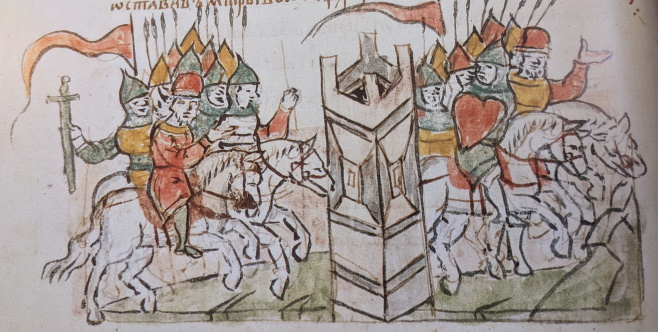
Until the 12th century inclusive, the forest land between Suzdal’ and Kiev was intricately associated with the Vyatichi tribe.[44]A tribe of East Slavs who inhabited the area around the Oka, Moskva, and Don rivers. By the 15th century, this association was unthinkable, and the name of the Vyatichi itself had already long been forgotten and become obscure. This makes all the more curious a feature which unites four miniatures which depict the Vyatichi. This is specifically the forest which the illuminator uses as a symbol of the Vyatichi lands. Groups of green or green and red trees play a significant role in the following three illuminations: 1) the Vyatichi pay tribute to Svjatoslav (34 rev. top); 2) the Vyatichi pay tribute to Vladimir (46 top); 3) Vladimir’s campaign against the Vyatichi (46 bottom). In the latter case, the trees compositionally correspond to the tower which normally is represented in campaign scenes. These towers are used to represent an entire city; but even for illuminators of the 12th century, the Vyatichi as a military target were a tribe, rather than a collection of cities or regions. In the miniature depicting Svyatoslav’s first meeting with the Vyatichi (34 top), where the large number of people did not allow for drawing trees, both of the Vyatichi figures are placed on green ground, surrounded by a wavy line, a device not seen elsewhere in the manuscript, but which has to be understood as a new method of representing the Vyatichi forests. There are quite a lot of depictions of trees in the manuscript, but it is not possible to assume these mentioned cases with the Vyatichi are mere coincidence. We can also add that a similar group of trees is also seen in the miniature depicting Yaroslav Svyatoslavich’s return from Kiev to Murom (161 bottom), that is, his journey through the Vyatichi forests. In the text accompanying each of these illuminations, there are no direct mentions of forests. It remains for us to assume that the original illuminations arose at a time when this association of forests with the Vyatichi was still active.
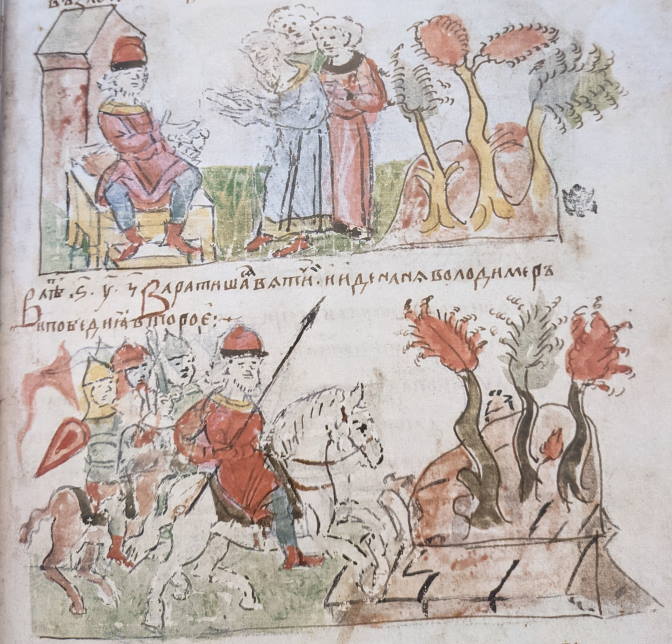
top: Vladimir Svyatoslavich negotiates tribute with the Vyatichi.
bottom: Vladimir Svyatoslavich’s second campaign against the Vyatichi.
Sizov also noted the burial mounds which make up the background for the burial of Tugor-Khan (133 rev.).[45]Sizov, op. cit., p. 44. There is also a direct representation of the creation of a burial mound, that of the burial of Igor’ (29 bottom). Ainalov incorrectly saw this as a divergence from the text of the manuscript. He writes: “in the miniature depicting Ol’ga’s lamentation (folio 29) of Igor’ at his grave, next to a hill which is mentioned in the manuscript in the description of Igor’s murder by the Drevlyani (“and Igor’ was buried, and his grave is there in the woods near the city of Iskorosten to this very day”), a grave is depicted as the illustration of the text where Ol’ga went “to his grave,” showing the figure of Ol’ga weeping over said grave.”[46]Ajnalov, op. cit., p. 321. In reality, there is no divergence, neither between the different passages of the text, or between the text and the illustration. To the right, we indeed see the grave in which, according to the text, Igor’ lay until his final interment. This grave was typologically correctly identified by Ainalov,[47]Ajnalov, op. cit., p. 322. but he did not notice the leftmost and largest part of the illustration, taken up specifically by the burial mound. The burial mound is shown in the process of construction (the only illustration demonstrating the method of building Russian burial mounds). Three diggers (there is no room to depict more of them) work with shovels while a fourth supervises. The shape of the mound is a rounded cone. Fresh shovelfuls of dirt are visible below, still retaining their shape of the shovel. There are three rows of thrown dirt. This directly corresponds to the following passage: “and she commanded her people to erect a great burial mound, which they did; and then she commanded them to hold a feast.”

A third illumination with a burial mound (82 rev.) is quite unique. It is dedicated to the death of Svyatopolk (the Accursed). The burial mound is shown as a cutaway. Its surface is light tan, the same color as the surrounding land. Upon this ground, we see the interior of the burial mound in dark brown, surrounded by a closed, broken line. On the horizon (to use the burial mound archeological term), Svyatopolk lies in his princely outfit, arms outspread. In this pose, the illustrator conveyed the scribe’s concept that Svyatopolk was unable to find peace even in death. The burial mound itself corresponds to the words: “and he is buried there in the wilderness to this day.” The burial mound is shaped as a truncated cone, a form that well known to archeologists, and is crowned by a tree. The method of showing cutaways was known to the illuminator (see, for example, the cutaway of a church in folio 111).
Burial mound rites no longer existed by the 15th century, if one puts aside the Novgorod zhal’niki which were not very similar to the specified images. In the 14th century, in the former lands of the Vyatichi, the peasants still buried using mounds. But the originals for the specified miniatures (again, all from the first artisan) arose, of course, at a time when the memories of burials using mounds were still fresh and wide-spread among the ruling class.
But, it would be in vain to search for certain ancient memories in these miniatures. For example, by the time the originals were painted, all sorts of ideas about Slavic idols had been resolved. It is true the illustrator does not shy away from this theme, and depicts them three different times (folio 16, folio 26 rev., folio 45). But in all three cases, Perun is depicted in the form of an almost antique statue, as a nude male, red in color, with a shield in his left hand and a spear in his right, and having nothing whatsoever in common with actual Slavic idols as they are now becoming known to us. The weapon thrown at Perun’s foot in one illustration (26 rev.) represents an ancient ritual feature, but this corresponds to the text. Distant antique reminiscences are generally encountered in the Königsberg Chronicle, as noted by Sizov.[48]Sizov, op. cit., pp. 15-16. Their explanation must be related to the explanations of those Byzantinisms and Germanisms with which they came. I could point to some column capitals which are almost Ionic (48 rev. top) and almost Tuscan (202 bottom). All of these antique reminiscences are of course not tied to the question of date, since they were updated all the time.
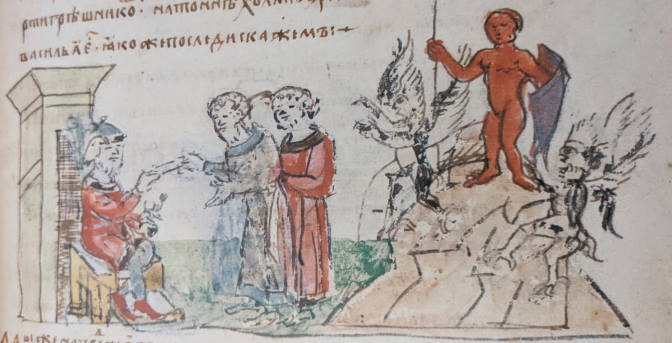
In two of the illustrations, Perun stands alone, but in the third (folio 45) he is seen as part of an attempt to depict Vladimir’s pantheon. In total there should be six gods shown, but here, as in many illustrations, the number of figures has been abbreviated. Perun is shown in the center, with a being with tall crests, wings and a tail on either side of him. In fact, these are traditional medieval Russian demons as commonly encountered on icons. They are frequently seen in other illuminations in the Königsberg Chronicle in their typical occupation of tempting monks. In this particular instance, they appear in the role of Slavic gods. As such, the representation of demons also cannot be used to date this work.
As for the question about the portraiture of royal images, it is risky to draw too many conclusions here, as they would likely be on shaky ground, but they may still lend information on the question of dates. When reviewing the miniatures, it is easy to notice repeated characteristics on the facial features of some (but not all) of the princes. With few exceptions, their true physiognomies are unknown. V.N. Tatischev published descriptions of the outward appearances of several princes which, along with other more important information, he was able glean from several chronicles which have since disappeared. Many of the Königsberg miniatures turned out to be quite accurate illustrations of these descriptions. We need only regret that the artist did not color in these princes’ hair and beards, even where their color was known (in general, this kind of coloring is rare in the Königsberg miniatures, although we do encounter blondes, brunettes, and brown-haired males). But, these coincidences do not suffice. According to Tatischev, Vladimir Vsevolodovich Monomakh had a wide, curly, tight beard.[49]Tatischev, V.N. Istorija Rossijskaja. Vol. 2. Moscow, 1773, p. 229. Out of the 20 miniatures dedicated to this prince, 15 correspond to this description, and the other 5 are unclear. Vsevolod Ol’govich was wide of beard and had a long nose.[50]Tatischev, op. cit., p. 281. Out of ten miniatures, nine match this description. Igor’ Ol’govich was lean, with a thin, narrow beard.[51]Tatischev, op. cit., p. 313. Out of eight miniatures, six match this desciption. Izyaslav Mstislavich’s beard was round and thin.[52]Tatischev, V.N. Istorija Rossijskaja., Vol. 3. Moscow, 1774, p. 82. Out of 34 miniatures, 25 match this description. Yuri Vladimirovich Dolgorukiy had a thin beard and a crooked nose.[53]Tatischev, op. cit., vol. 3, p. 103. Out of 13 miniatures, 10 match this description. These observations allow us to suggest there was an iconographic tradition dating back to the 12th century.
Almost all of the archaisms which I have listed in this chapter belong to the first artisan and are linked to his stylistic archaisms, as clarified by Artamonov. Only one of the ancient swords (38 rev. bottom) and a few portraits of Izyaslav and Yuri are attributed to the second artisan. In any event, the imitation of ancient examples seems to have fettered the free fantasy and wit of the second artisan the least.
The annals had a long history in our land, of which the Königsberg Chronicle remained an isolated monument. Tradition was an inherent characteristic of feudal writing. The layouts and details of the miniatures were tenacious, and outlived the social environment which created them. But, we should not overestimate this tenacity. Changes were continual. They were gradual while the generations of keepers of tradition, such as the first artisan, were at work. They became faster when brave innovators, such as the second artisan, appeared. Nevertheless, as we have seen, the Königsberg Chronicle preserved enough of these subject archaisms that they bring to mind the position taken by Shakhmatov, who claimed based on textological evidence that “the manuscript’s illuminators, just as with its text, reproduced an illustrated monument of the 13th century, most likely from the first quarter of that century.”[54]Shakhmatov, op. cit., p. 103.
Of course, such an assertion can only be true with regard to the illustrations. In any event, it is necessary to outline the dating of these miniatures in order to rely upon them as historical sources. I have highlighted here several ancient symbols. There are significantly more later symbols which date to the 15th century and are contemporaneous with the lives of both artisans. Sizov has written about them in detail. I have mentioned some of these later data, and shall have the opportunity to mention more. These strata from different time periods increase our interest in the artisans.
Part IV – Militaristic Details
I would not propose to repeat here all of the conclusions and decisions made by prior scholars, as that would not be interesting. The exception would be the many cases where I disagree with those conclusions and where, in my opinion, they need further elaboration. Archeological conclusions of many depicted items have already been made by Kondakov, Ainalov, and in particular by Sizov. Nevertheless, there is still a lot of work left to be done.
Foremost in the Königsberg Chronicle’s miniatures, evidence of military organization and equipment catches the eye. This is understandable for any feudal historiography, in particular for our illustrated historical chronicle of princely strife. The abundance of cavalry detachments, skirmishes, and campaigns which appear as the common compositions are not surprising. The predominance of cavalry is generally typical for early feudalism, and this appearance can be followed with the same success in the miniatures of western European, Byzantine, and Near-Asian works.

Our illustrators generally ignore the infantry. There are quite a few individual foot soldiers, but they are either sentries, or representatives sent by the army. There are no infantry battles at all, aside from popular uprisings, which I shall discuss separately. A detachment of foot soldiers in armor is depicted only once (folio 117 top); the same miniature also shows a cavalry detachment, and relates directly to the text: “Izyaslav, standing among his foot soldiers….” Another exception also confirms this rule: the foot soldiers of the Vladimir army bowing to the Vladimir icon on the field of battle against the Volga Bulgars (folio 205). Scenes of battle were commonly conveyed with a focus on their ferocity, with an abundance of blood, severed heads and arms; but even more often, there are scenes of pursuit, which more clearly illustrate stories about victories in battle.
It is easily apparent that leaders are depicted armed with swords or sabers, while ordinary soldiers typically are armed only with spears. This can be seen in illustrations of detachments of soldiers, as well as in the figures of individual soldiers. Archeologists have found large, rich burial mounds of soldiers with swords, as well as medium-sized burial mounds for soldiers with spears. Ordinary peasant burial mounds rarely contain weapons.
All soldiers are shown in helmets, while the princes are depicted, even in battle, wearing their unchanging princely hats (see below). Eastern soldiers often wear kalpaks [high-crowned Central Asian caps], as Sizov has already noted,[55]Sizov, op. cit., pp. 23-24., but typically they wear the same helmets, armor, and weapons as the Russians. I will note that the kalpaks are worn not only by the Pechenegs, Khazars, Kassogs, Turks, Berindei, and Polovtsians (as Sizov noted), but also once are seen on Volga Bulgars (folio 158 top). In all other illustrations (which are pretty frequent), the Volga Bulgars are identical to the Russians. I will note, however, that Volga Bulgar legates are shown in one case in peculiar, pink, spherical hats with wide transverse ridges (folio 48). The leaders of the Pechenegs, Turks and Polovtsians are shown quite singularly in seven illustrations, with any headwear, and typically with bald heads. This sharply contrasts against their armor (folio 67, folio 68, folio 148 bottom, folio 152 rev. top, folio 153 rev. top, folio 158 bottom, folio 203 bottom). The origin of this method of indicating these Eastern leaders is unclear.
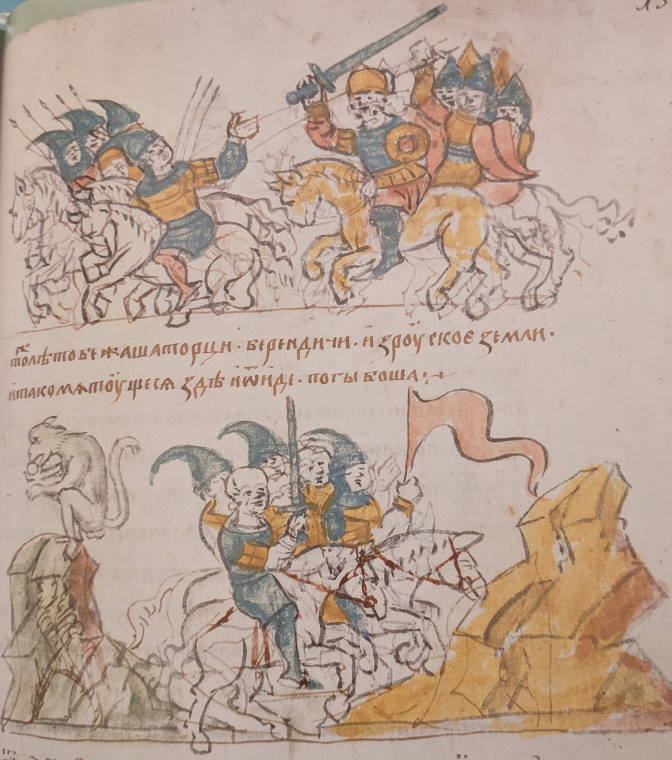
top: Yuri Vladimirovich Dolgorukiy of Rostov’s campaign against the Volga Bulgars and his victory over them.
bottom: The flight of the Turks and Berendei from Russian lands.
Sizov has already described several methods for depicting sets of layered armor.[56]Sizov, op. cit., pp. 32-34. In the majority of cases, due to the schematization of the drawings, it is not possible to distinguish such armor from chain mail. Nevertheless, it seems to me that the predominance of chain mail, as established specifically for Rus’ by museum collections, is also supported by the miniatures. The gathers of chain mail are frequently indicated by shades of paint, and sometimes also graphically. They are especially seen when the wearer lifts their weapon aloft (for example, folios 27 rev., 30 rev., 79).
Various types of shields were also described by Sizov. The majority of shields are painted red, with yellow encountered significantly less frequently, and other colors even more rarely. This recalls an important scene in The Lay of Igor’s Campaign: “The Men of Rus with scarlet shields, fortified the great steppe, / seeking honor for themselves and glory for their prince.”
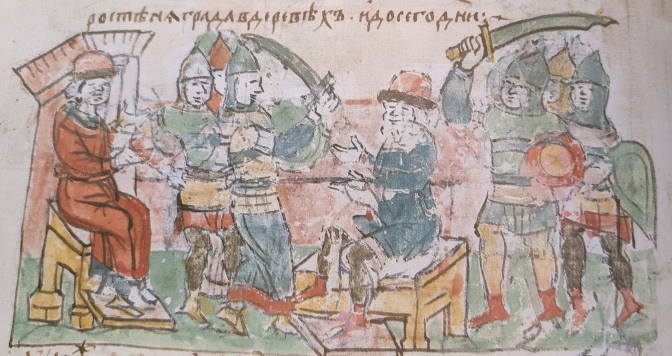
Among other places, rows of multi-colored shields are lined up along the sides of boats. Generally speaking, we see war campaigns depicted on the Black Sea, the Volga, and the Dnieper. In these boats, we see the same soldiers in helmets, alongside naval helmsmen and rowers in civilian dress. [jeb: See folio 97 rev. top]
Despite Kondakov’s opinion,[57]Kondakov, op. cit., p. 117. there are more swords than sabers in the manuscript. There are 220 swords, and 144 sabers (there are in addition 42 hilts which cannot be differentiated). I already discussed sabers above, and singled out the four swords that were of ancient shape, and the two that were latest in shape. Swords with disc-shaped pommels are wide straight crosspieces are predominant, which were pervasive in the 12th century and were predominant in the 13th and 14th centuries. They are shown equally as hacking or stabbing – the blade was useful for both purposes. Schwietering undertook a special study of these swords in the West, which shows evidence of them in reproductions of German and French miniatures from the 12th and 13th centuries.[58]Schwietering, Julius. Zur Geschichte von Speer und Schwert im 12 Jahrhundert. Hamburg, 1912, illus. 14-17. The same swords are also seen in the Czech Velislav Bible from the 13th century. The Historical Museum collection includes swords found by P.A. Viskovatov’s excavations in the Pyukhtitsky Monsatery in Estonia, near Narva. The Hermitage also contains these swords, including one which was found in the village of Radomlo in the Kremenets district in the Volynsk region, and another near Makretskaya Dacha in the Kozelets district in the Chernigov region. The Hermitage’s 14th century sword of Emir Gars-Eddin is also similar to these swords.[59]Lents, E. Ermitazh, Ukazatel’ otdelenija crednikh vekov. Chast’ I: Sobranie oruzhija. St. Petersburg, 1908, pp. 301-302, 305; Lents, Al’bom sobranija oruzhija…, plates XXI, XXXI. In the Königsberg Chronicle, a large number of swords are depicted too sketchily to be able to categorize them. But, all of the categorizable swords (aside from the exceptions described above) belong to this type (up to 100). Strictly speaking, these wide, straight crosspieces and round, disc-shaped pommels were already archaistic.
Drawn swords and sabers are almost always shown in blue, or occasionally white. Their pommels were also typically blue, but sometimes are yellow or gold on princes’ swords. There are other colors as well. Scabbards are shown in all colors.
Spears are typically black and white, sometimes brown and red, and very rarely blue. They are commonly depicted as a simple line, and cannot be categorized. But, this is far from always, and in some cases, typological differences can be made out. Leaving out all of the disputable instances, I shall give a list of the clearest archeological analogies for these spears, according to Materials on the Archeology of Russia (MAR), as well as Peterson.[60]Petersen, op. cit.. The type from MAR, iss. 20, table XVIII, item 15 is seen on 16 illuminations; MAR, iss. 29, table XXVI, item 5 is seen on 14 miniatures; MAR 20, iss. XVIII, item 28 is found in 6; MAR, iss. 20, table XVIII, item 29 is found in 5. Finally, the following types are encountered once each: Petersen, illus. 7; Petersen, illus. 8; MAR, iss. 20, table XVIII, item 22; MAR, iss. 20, table XVIII, item 24, and MAR, iss. 29, table XXVI, item 4. In other words, in 32 instances we see leaf-shaped spears, and in 14 we see diamond-shaped spears. Forests of spears rising above cavalry detachments is a common pictorial technique used by the first artisan (it is encountered with the second artisan as well, but rarely).
Arrows are occasionally encountered and also have archeological analogies. Diamond-shaped arrow heads, the most common sort used in Rus’, are seen twice (folios 15 top, 22 top). In three cases (folios 102 bottom, 145 rev., and 217 rev. bottom), we see barbed arrows (thanks to these barbs, it was impossible to remove the error without further expanding the wound). In one case (217 rev. bottom) we see a double-pointed arrow (which created a greater area of damage). Arrows are all brown or black in color.

V.I. Sizov indicated a spur on one of the miniatures, “pointing downwards, long, with a toothed wheel.” He notes its dissimilarity to Russian spurs found on Knyazh’ya gora, seeing it as a depiction of a later, knightly type of spur.[61]Sizov, op. cit., p. 19. He is essentially correct. But, it is necessary to note that, first of all, there is not one example of these spurs in the Königsberg Chronicle, but rather 10 of them; and secondly, this generally European type of spur also existed in Eastern Europe. The Historical Museum collection contains two examples. One of them was found near the village of Trakhtemirovka in the Kanevsky district in the Kiev region, and the ohter in one of the Leningrad burial mounds (excavation by L.K. Ivanovsky – further details unknown, as it has not yet been published). The toothed wheel had a medieval Russian name, and was called a “burdock” [Rus. репейка, repejka]. Their dates were established according to Demmin. Both of the indicated museum examples and all of the spurs in the miniatures date to the 14th century, while the example from Knyazh’ya gora (which was also a common European type) dates to the 10th century.[62]Demmin, Auguste. Guide des amateurs d’armes. Paris, 1879, p. 365. Spurs are painted brown and black in the miniatures.
I previously wrote about the images of six-flanged maces in the chronicle. There is also one case of a spherical-headed mace, dark blue and apparently made of iron, also in the hands of a prince (Gleb Yur’evich).
In once case, we see a poleaxe depicted, with a crescent-shaped, symmetrical blade (folio 96 rev.) which, as V.A. Gorodtsov has already noted, has a series of analogies from various dates.[63]Gorodtsov, V.A. “Opisanie kholodnogo oruzhija.” Otchet Ross. Istoricheskogo muzeja za 1906 g. Moscow, 1907, pp. 106-107, illus. 43. The blade is shown in blue. The bardiche which which Gleb threatens a wizard (folio 106 top) was more common of later times. This type is similar to one mentioned by Savvaitov,[64]Savvaitov, Pavel. Opisanie starinnykh russkikh utvarej. St. Petersburg, 1896, p. 112. and is depicted in blue.
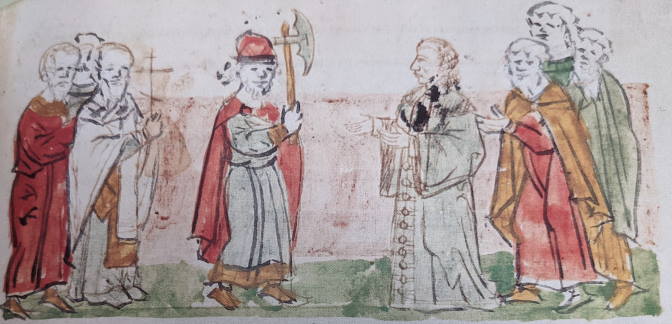
Only the second artist, who was more of an innovator, depicted artillery. V.I. Sizov already noted three of these depictions.[65]Sizov, op. cit., pp. 40-41. In total, there are six (folios 195 top, 201 bottom, 209 rev., 217 rev. bottom, 225 rev., 236 rev. bottom). In each case there is a single cannon, which sticks out from the bottom of a fortress wall. The elimination of early feudal fragmentation and the so-called aggregation of Rus’ was accompanied by artillery weapons. Cannons appeared in Muscovite Rus’ in the second half of the 14th century. By the 15th century they were in widespread use, so their appearance in the miniatures is not surprising. A characteristic gunner, without a hat and in civilian dress, is seen in one image (folio 209 rev). Working at his cannon, he observes the effect of his shot on the enemy cavalry, which has become fettered in iron.
The cannon are smoothly cylindrical, except for one, equipped with transverse reinforcing rings (folio 217 rev. bottom). Three of the cannon are green, and the remainder are red, pink, and blue. The cannon carriages are yellow. Cannon which are being fired have red muzzles (the color of fire). The shot (folio 209 rev.) is yellow.
Army carts are seen several times. The carriage drivers are always shown seated on draft horses, a manner known from ethnographic literature. I witnessed this myself during archeological excavations in the Novgorod countryside.
Fighting techniques are accurately depicted in the battle scene between Rededya and Mstislav (folio 83 rev. bottom). Rededya seizes Mstislav by the front of his belt. Mstislav works to trip him.
Of particular interest are the weapons of insurgent townspeople and peasants. Commonly, townspeople are seen with spears and swords. There is also a flail (folio 179), relatively typical in form, consisting of a weight chained to a rod. Ethnographically, this type of tool was called a “slungshot” [Rus. гасило, gasilo]. And, particularly interesting is the ordinary working axe with which (in the absence of other weapons) a rebellious peasant opposes a feudal lord armed with a saber (folio 103).
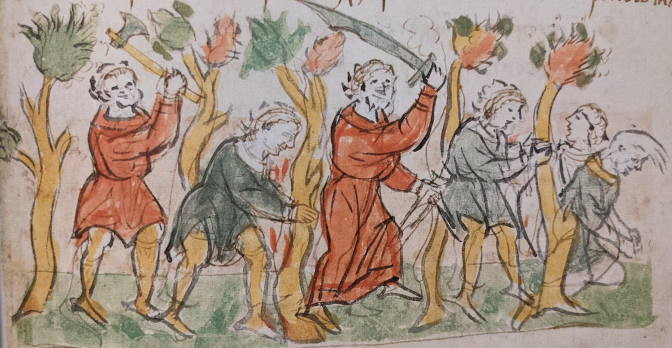
Part V – Agriculture, Construction, Crafts, Trade
Scenes of labor are encountered significantly less frequently in the manuscript than scenes of battle, and tools of labor are shown less well than weapons. The most important tool of the epoch, the axe, is shown in 16 miniatures. All of the axes are of a single type. There is a single exception (folio 99 rev.), and we described the two axes in that image above. In all of the others, we see only one and the same silhouette: a curved top edge, an even more curved lower edge, and long, arched blade, an elongated butt, and a straight handle. This type of axe has been relatively commonly found in Russian burial mounds and has been published repeatedly.[66]See, for example, Izvestija Arkheologicheskoj komissii. No. 15, illus. 394; Materialy po arkheologii Rossii (MAR), No. 29, plate XXVI, no. 6. In 15 miniatures, we see 27 of these axes depicted. They are painted blue. They are depicted most frequently in scenes of construction. The straightness of the handles for the burial mound axes, theoretically established by V.A. Zheligovsky’s calculations, are supported by these miniatures. The first illumination of the manuscript, “Novgorod the Great,” depicts the building of a log cabin using these axes (folio 3).
Five miniatures depict shovels. In the first three, they are small and resemble the shovels from the Ladoga burial mounds, which confirms the suspected purpose of those archeological finds. In the second illumination of the manuscript, next to the Apostle Andrew who is raising a cross, we see a digger who is digging a hole for the cross (folio 3 rev.). The shovel is white, small, and analogous to one found in the Ladoga region village of Zaozerye during a dig by W. Raudonikas.[67]Raudonikas, W. Die Normannen der Wikingerzeit und das Ladogagebiet. Stockholm, 1930, illus. 38. In the scene we described above of the digging of Igor’s burial mound (folio 29 bottom), we see two shovels half-hidden by dirt but of roughly the same shape. The one on the left is entirely in blue, that is, made of iron, while the one on the right is brown with a blue border, or wooden with a metal reinforcement.[68]jeb: Similar shovel reinforcement plates have since been found in Novgorod, see https://rezansky.com/the-blacksmithing-arts-of-novgorod-the-great/#Illustration62. In a scene showing the cutting of the Korsun aqueduct (folio 61), there are again 2 shovels. Both of these are white and small, and both widen at the bottom similar to the majority of the Ladoga region shovels. As an analogy, see, for example, the items found in the Ladoga villages of Schukovschina and Syazniga in exavations by N.E. Brandenburg.[69]Materialy po arkheologii Rossii. No. 18, plate IX, nos. 8 and 9. Significantly larger shovels are shown in the scene of Tugorkan’s burial (folio 133 rev.). In shape, these are already similar to modern shovels. Both are shown in yellow with blue borders, that is, wooden with iron reinforcements, a form still encountered today in our rural areas. The upper half of the shovel in the illustration is not reinforced; the reinforcing plate is in the shape of a thick letter C and covers almost the entire lower section of the shovel, aside from a small area in the center. Finally, there is an even larger yellow (wooden) shovel, enormous even by modern standards, in the scene of the draining of water from the city of Pronsk (folio 236 rev. bottom). The shape here is almost triangular. The method of work used by diggers in each of these scenes is the same as used today, known to every archeologist from there own experience. All of the shovels described are of particular interest in light of the lack of archeological materials for medieval Russian shovels.

In one of the scenes depicting the Monastery of the Caves, we see a spade?? [Rus. рогалье, rogal’e] being used to dig in the earth, as mentioned in the text (folio 121 rev.). In the illustration, we see if being used like a hoe. It is shown in blue.
Axes and shovels were basic construction tools. Scenes of building depict half-built log cabins, consisting of several yellow logs. The conventionality of this drawing does not allow us to study the design features, but it is nevertheless possible to note, for example, that the boards have been joined using dovetails (folio 67 rev. bottom).
Less frequently, we see stone masonry depicted. In surviving medieval Russian buildings, we see both messy masonry, as well as well-dressed stonework. The latter is denoted by the fact that the seams of each middle row fall against the body of stones in the upper and lower rows. In three miniatures (folio 84 top, Tmutarakan; folio 87 bottom, Kiev; folio 204 rev., Vladimir), the stonework is well-dressed; in one (folio 107 rev. bottom, Kiev) it is messy, and on one (folio 202 top, Suzdal’) there are technically meaningless vertical seams.
The Königsberg miniatures do not contain any depictions of the most important craft, blacksmithing. It is true that twice we see smiths depicted, but both times they are shown busy with a very specific practice which is quite characteristic for the manuscript’s contents, that is, they are shown riveting chains in scenes of arrest (folios 140, 148 rev. top). Out of all the various tools of the trade, both times we only see a hammer. In the first image, it is white and quite indistinct. The chains are also white. In the second image, the hammer is small and quite straightforward. We could show archeological analogies to it, but in light of the lack of clarity in the illustration, this would be unfounded. The hammer and chains here are both blue.
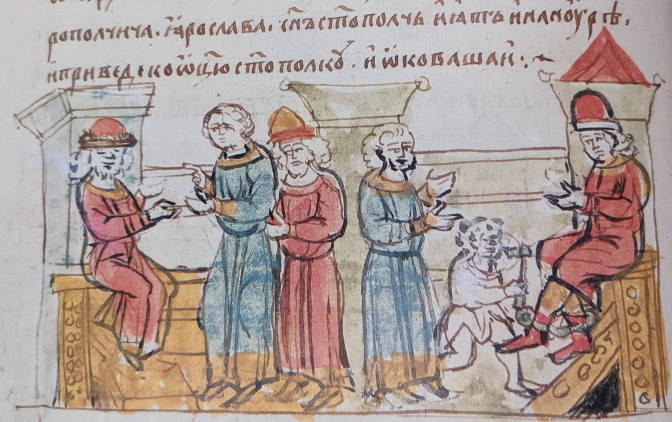
Items produced by blacksmiths include all of the tools listed above, as well as the weapons. We may also note a large conical nail (folio 22 top) and the palmetto-shaped decorative hinges [Rus. жиковина, zhikovina] (folio 124 top) in a shape still characteristic today for Russian folk art.
On the final miniature (folio 245 rev.) we see one more craft tool depicted – scissors. It is important to note that these are not the so-called sheep-shear (spring) scissors encountered in burial mounds, but already the modern form of scissors with handles (articulated scissors).[70]jeb: Both spring and articulated scissors have been found in Novgorod as early as the 10th century. See https://rezansky.com/the-blacksmithing-arts-of-novgorod-the-great.
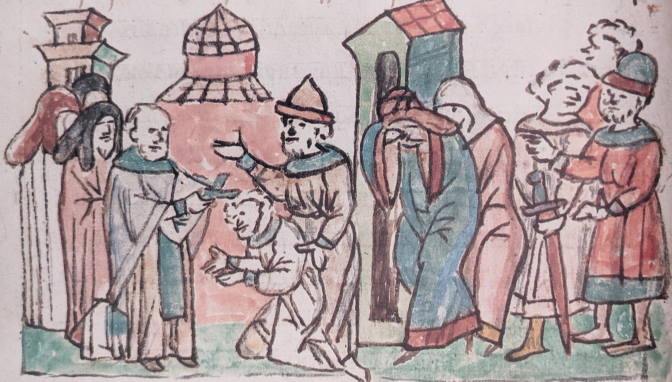
Material about agriculture are even more poorly represented than that about the arts and crafts. However, there is a depiction of a plow (folio 7). This is not a primitive wooden plow [Rus. соха, sokha], but a proper plow [Rus. плуг, plug], that is, a tool for turning the earth in layers; the depiction even shows spoked wheels on the front of the plow. It also has a plowshare, with a metal reinforcement over a wooden base. The blade is of the so-called “binae aures” type. Only the coulter is missing to make this plow complete, but cannot this be assumed based on the second handle, when one would have been sufficient? In general, we have here a well known form of plow, which developed in the early common era in Rome[71]Artsikhovskij, A.V. “Sotsiologicheskoe znachenie evoljutsii zemledel’cheskikh orudij.” Trudy sotsiologicheskoj sektsii RANION. Vol. 1. Moscow, 1927. and which was widely used in feudal Europe (see, for example, the famous Bayeux Tapestry). But, there is no data to date about their existence in medieval Rus’. Keep in mind, medieval Russian agricultural implements are in general poorly understood.[72]jeb: A few instances of medieval coulters were found in Novgorod about 10 years later, from as early as the 11th century. See https://rezansky.com/the-blacksmithing-arts-of-novgorod-the-great/#Illustration56. Coulters were blades that cut the turf ahead of the plow, making it easier for the plowshare to turn over the earth.
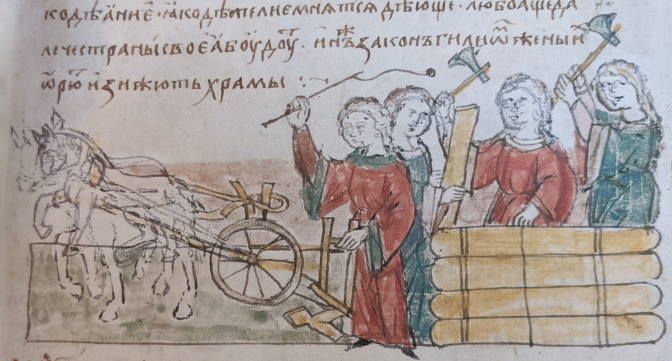
There are few depictions of livestock. Among the spoils of feudal raids, livestock are sometimes shown alongside prisoners: horses and cattle (folios 166 rev. middle, 196 bottom, 207 rev. bottom, 210 rev. top), sheet (folio 210 rev. top), and goats (folio 196 bottom). An ox is mentioned in the story about a bogatyr (folio 68 rev. bottom), a ram is given as tribute by the Chud (folio 164 bottom), and a cat is seen in a marginalia (folio 161 bottom). Pigs are shown only once, being ridden by a demon (folio 110 rev.). It seems the artisan was unsure how to draw the donkey into which an abbot was turned; instead, he gives us a small horse with slightly elongated ears (folio 111).
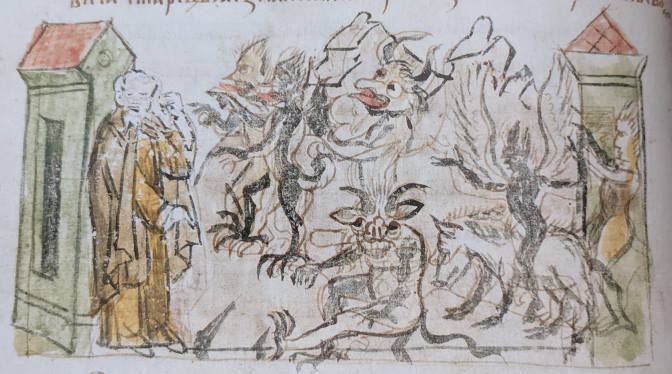
Valuable evidence of hunting, or more precisely, the fur trade is provided by five miniatures which depict tribute being given in furs. I will note in passing that furs are usually not mentioned in the text; as such, this form of tribute must still have seemed natural for the artist (all of these illustrations are by the first artisan) or for the one who painted the originals.
The depiction of furs are quite clear on three miniatures (folios 5, 20 rev., 136 bottom). According to B.A. Kuznetsov’s kindly input, these are marten furs, bundled in a manner called a “round riot” [Rus. круглый бунт, kruglyj bunt]. This method is still used to this day by Russian hunters, with the furs carried on rings made from willow branches. We can also see this ring in these illuminations. Martin furs are always bound using this method. As such, the antiquity of this method is evidenced by the Königsberg Chronicle. Further study of such features may allow us to understand much about certain medieval agricultural documents, for example, those from Novgorod. On the other two miniatures (folios 8 bottom, 164 bottom), the furs are a bit indistinct, but it appears that the same interpretation applies to both of these cases.
A hunt is depicted in the scene of the murder of Lyut Sveneldich (folio 41 top). The action takes place in a forest, and to the right we see a red deer in white, with yellow horns.
Out of the remaining animals encountered, we should mention the elk in a landscape of drought, magnificent in its expressiveness and harshness (folio 124 rev.). The elk is greenish, with yellow horns.
Twice we see bears depicted in the margins. One of these (folio 155 rev. top), as V.I. Sizov has already noted,[73]Sizov, op. cit., p. 15. symbolizes the forest cover of the conquered lands of the Yatvingians (this is a very wittily-drawn, cheerful bear cub, sketched in grey ink). The second bear, in brown, has the same meaning (folio 162 bottom). The text talks about Vyacheslav Vladimirovich’s campaign through the Minsk forested lands, and as such this appears once again to be a symbol of the forests.
The remaining animals belong to the realm of fantasy or exoticism. For example, see the monkey mentioned for some reason in the story about the flight of the Turks and Berendei. The monkey is drawn relatively faithfully, but is colored green and white (folio 158 bottom).
There is no direct evidence of beekeeping, but of value are the three circles depicted on the table in the scene of Igor’s reception of the Greek ambassadors (folio 27 top). In the text, it says: “he sent away the ambassadors, having gifted them with furs, slaves and wax.” The circles are yellow, with a wax-like shade. From Novgorodian business documents, we know that wax was sold in “wheels” (the technical term) and stored it in this fixed shape (with a seal stamped on the top).[74]Nikitskij, A.I. Istorija ekonomicheskogo byta Velikogo Novgoroda. Moscow, 1892, pp. 166, 173, 276. The manuscript has preserved here a contemporary depiction of these trade units.
From the data present about the techniques of transport, the most interesting is a depiction of the docks on the River Oka in Ryazan’ (folio 227 rev. bottom). The green pier buildings with their red gabled roofs, a three-horned yellow mooring post, a yellow fence along the shore, and the white gangways with white railings are clearly depicted. A man (a companion of Vsevolod Yur’evich) stands on the gangway, looking at the princes who stand on the shore. We have here an accurate depiction of a medieval Russian dock, an otherwise completely unknown structure. In this miniature, painted by the second artisan, the details listed above give evidence of the relatively high level of organization of river transportation, the most important method of transport in medieval Rus’, which had such a large significance for our cities.

Part VI – Depictions of Church and State
The manuscript’s client was a feudal lord, and this best of all explains many of the miniature’s features. The illustrator had a firm mastery of the concepts of social hierarchy typical of the feudal epoch, especially in his depictions of headwear. The princes from Ryurik (and even earlier) to Vsevolod Yur’evich are depicted, with only rare exceptions specified by the text (for example, princes who have been exiled or deposed), in one and the same kind of hat, soft, spherical in shape, trimmed in fur. This type of had, repeatedly encountered in several hundred miniatures in the Königsberg Chronicle, is also known based on other sources.
The earliest depiction is the hat was on a famous giant, four-faced Slavic idol found at Gusyatin at the bottom of the Zbruch River. This hat strikes me as one piece of evidence that this idol belonged to the princely-retinue pantheon of Slavic paganism. This was a god of the having-just-appeared ruling class. All of the attributes of this idol are characteristic: its sword was the weapon of a feudal lord (see more on this above); below the sword is his warhorse (cavalry was a common feudal cohort); the ring, a one-time symbol of power; and his rhyton or drinking-horn. Drinking horns are known to have been princely vessels from the Black Grave (excavation by D.Ya. Samokvasov), from mentions in manuscripts (“he gave the Pskovites an aurochs horn covered in gold”)[75]Polnoe sobranie russkikh letopisej. Vol. V, p. 43. and by depictions in the Königsberg Chronicle (yellow and most likely also gold-plated drinking horns are seen, for example, in folios 203 rev. top, 222 top, and 237 rev. top.).
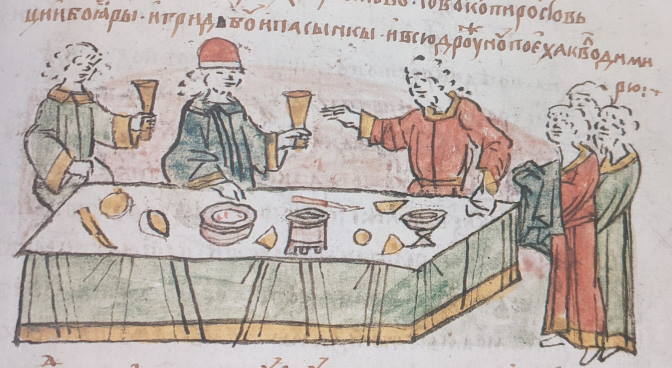
But, let’s return to hats. We see the same shape in the 1073 portrait of Svyatoslav Yaroslavich in the Svyatoslav Izbornik. It then lasts for several centuries. It would be impractical to list all of the manuscripts where it appears. This type of hat is also frequently encountered on icons.
In the Königsberg Chronicle, this type of hat has a singular meaning. Almost all princes are crowned with one, with the number and location in the illuminations strongly corresponding to the text. Princes are also sometimes mentioned in pointed gold crowns and in poofy, turban-like hats [Rus. туф, tuf]. But, this type of hat is only worn by princes. Only rarely do we see persons, not mentioned in the text, awarded one of these hats, but in each case, we’re able to determine by context that they are lesser feudal lords summoned before their overlord.
What kind of hats were citizens allowed? Soldiers are shown in helmets, and all remaining individuals are shown without any headwear. The understanding of social rank also extends to long clothing. Long dress is worn by city elders, retinue seen in domestic scenes, and witnesses to historical events, while short shirts are worn by craftsmen, diggers, oarsmen, and peasants. Everyone stands before the princes, and are seen seated only when it is directly required by the text. In general, the illustrator was unable to violate the feudal concepts of social rank. It is interesting, then, to see the places (which I’ll describe below) where this understanding was violated in depictions of Novgorodians. Foreigners’ headdress stand apart, and are varied and sometimes bizarre. Sizov has written extensively on this topic.
The domed shape of these princely hats is generally-speaking required, while the fur trim is typically seen, but is not always emphasized in schematic illustrations. They are seen in a variety of colors. At the beginning of the manuscript, princes are usually seen wearing red hats, but then this color become less common than yellow, blue, and other colors.
With only a couple exceptions, the illustrator doesn’t even allow the princes to wear helmets in battle. In hundreds of battle scenes, the princes’ hats contrast against the helmets that surround him, or even his own armor. It is also revealing that, despite all church conventions and the so-called Pauline epistles, princes are shown wearing these hats even while at prayer. There are dozens of such examples. Yaroslav Vladimirovich has not taken off his hat in church (folio 90), even when receiving a priest’s blessing (folio 91 bottom). Izyaslav Yaroslavich is seen bowing while wearing a hat. Andrei Yur’evich is even depicted wearing a hat in front of the Icon of Vladimir (folio 200 rev. bottom, 205 rev.[76]jeb: see featured image at top of page.). For the illustrator, the traditions of the church are less important than the traditions of symbolism of feudal hierarchy. Sometimes, these traditions even come into conflict with the text. In one case, the illustrator himself noted this contradiction. He depicted Andrei Yur’evich in battle wearing a yellow princely hat (folio 191 rev. top). But, after the illumination, the first line begins, “his helmet flew off.” This was awkward, so the illustrator lightly drew the outline of a helmet over the hat. Princes’ sons are typically shown without hats, but once we seen them depicted even on very young children (folio 35 rev. top).

The symbolic meaning of the princely hat is sometimes quite clearly visible. When the Suzdal’ ambassadors invite Yaropolk Rostislavich to become prince of Chernigov, the young Yaropolk in short dress and tights stands without a hat next to a throne where Svyatoslav Vsevolodovich sits wearing his princely hat. But, the ambassador in front holds a princely hat in his hand. This hat, prepared for the coronation, has the same significance as genuine regalia (folio 217).
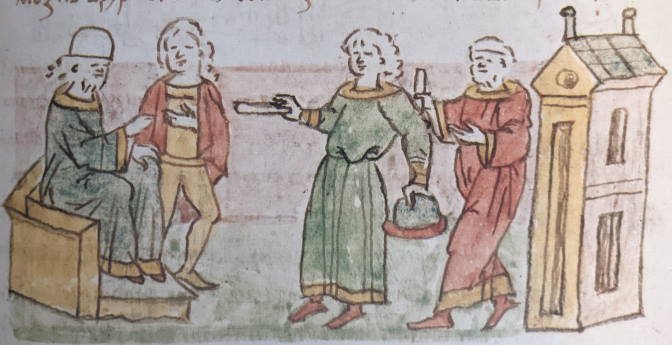
There is also an illustration of the opposite meaning. In the scene where Mstislav Romanovich is captured, he is not wearing his hat, which lies on the ground next to him. Given the lively nature of the scene, we could suppose that it fell off during the battle, but this does not weaken its symbolic meaning (folio 241 rev.). When Igor’ Svyatoslavich (the subject of The Lay of Igor’s Campaign) is captured, although he still wears a hat, a second princely cap is seen on the ground as a symbol of his defeat (folio 233 rev.).
Of particular interest are the patterns of feudal organization of power. They are encountered frequently and are painted, if one may say so, with diagrammatic accuracy. They are far from uniform and correspond to different types of feudal government. On one of the earliest pages of the manuscript, even before the story of Ryurik, we see a scheme of Byzantine feudal hierarchy. This is shown simply by the first mention of a Byzantine emperor, namely Heraklion. He is seated upon a large throne and holds a sword. Upon his head we wears a gold, pointed crown, which is also seen elsewhere in depictions of Byzantine emperors (previous authors have already written sufficiently on this topic). This is a suzerain. To either side, there sit his vassal lords on smaller thrones, in Russian princely hats. Finally, ordinary citizens approach from either side. They are completely without hats, and are standing (folio 5 rev. top). Of course, this type of system arose long before the Königsberg Chronicle alongside church propaganda about the power of the Byzantine emperor. This is one of those archaic elements which I mentioned above.
The Russian princes were for a long time factually equivalent in power (naturally, the strongest of them), and the power of the Grand Prince was mostly nominal. This can be seen well from many of the miniatures. The brothers Ryurik, Sineus and Truvor are depicted as three equal princes on three thrones (folio 8 rev. bottom). Ryurik’s advantage can be seen from the fact that his figure is slightly larger. The entire composition is almost just as symmetrical as the Byzantine composition with Heraklion, but has the opposite meaning. We still see the same servants without hats between the princes. Sineus is shown in the middle.
The princely councils convened several times by Svyatopolk Izyaslavich are also well known and often commented upon by historians. One such council in Uvetichi is depicted in a special miniature. Four princes are seated upon a common curved bench and are in discussion. Their equality is emphasized by the composition.
The princely councils convened several times by Svyatopolk Izyaslavich are also well known and often commented upon by historians. One such council in Uvetichi is depicted in a special miniature. Four princes are seated upon a common curved bench and are in discussion. Their equality is emphasized by the composition. From among them, it is possible to make out Svyatopolk, as well as Oleg Svyatoslavich and Vladimir Monomakh based on their consistent portraiture throughout the manuscript (the fourth prince is David Svyatoslavich). To the right stands a group of subjects without hats (folio 147).
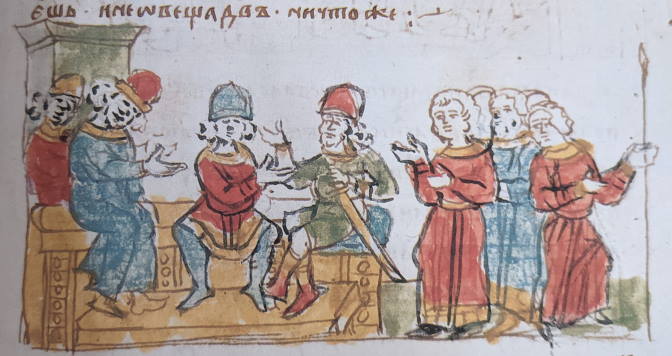
At least eight princes sit on a common bench in one of the scenes of peace treaties with the Polovtsians. This host is assembled such that it seems like a single being. The two princes in front even speak with the Polovtsian ambassadors at the same time (folio 148 bottom).
The people of Polotsk bow before a group of Novgorodian and Smolensk princes who are also seated upon a common bench. However, here we see three of the princes are of greater importance. Two others, also in princely hats, stand behind the bench (folio 239). This reminds us that the equality existed only between the most powerful of princes, who had many vassal princes under their command.
Yaroslav Vladimirovich’s co-rule with his brother Mstislav of Tmutarakan is illustrated by a characteristic miniature (folio 85 bottom). The composition is once again symmetric. Yaroslav and Mstislav are seated upon thrones on either side, wearing princely hats. Before each of them there stand three subjects without hats. But, this symmetry is broken by the fact that Mstislav is significantly smaller in size. This reminds us of Yaroslav’s superiority.
There are also scenes which depict the relationship between overlords and vassal princes. It is enough, for example, to glance at the miniature where Vladimir Svyatoslavich distributes cities to select Varangians (folio 44 rev.). He is seated upon a throne in a princely hat. Before him stand three Varangians, bowing, also in princely hats. To the right, there are riders in helmets – Varangians whom Vladimir considered to be unworthy of honor.
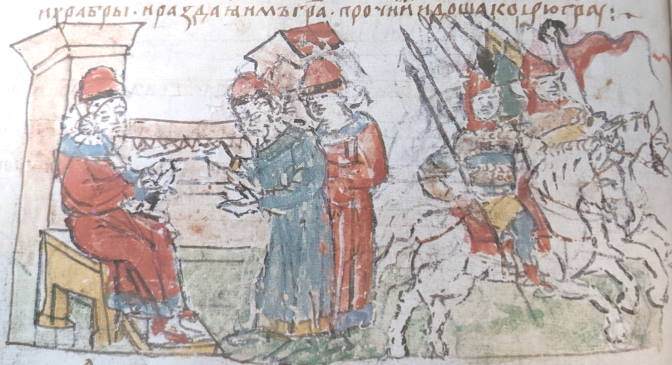
Finally, an interesting symmetrical composition reflects the strengthening of the Grand Prince’s power. The illumination depicts Yuri Vladimirovich Dolgoruky of Suzdal’s final reign in Kiev (folio 200 rev. top). Yuri himself sits upon a throne in the center in a princely hat and holding up an unsheathed sword (Kiev cost him many years of warfare). To his left and right are two princes in princely hats, but these princes are standing (many vassal princes went to Kiev with Yuri). On either side there also stand two servants without hats. The Vladimir-Suzdal’ system of supreme and hereditary princely power seen here sharply contrasts to the groups of princes seen from the Monomakh years.
Let us look at an example of a scene of leadership. Roman Rostislavich sits on the Kievan throne which he has just seized, with one hand on a spear and the other on a shield. His triumphant pose is characteristic and somewhat comical. To the left, three citizens stand without hats, and to the right we see two men from Roman’s retinue, in unique hats and holding swords (folio 212 top). Scenes showing the military seizure of power are relatively common. Inherited rule is shown through funereal scenes, where the princely hat of the new prince stands out amongst the group of people mourning the deceased (the rest of these people are, of course, without hats). The second artisan also depicts scenes where the prince is selected or invited to rule, the significance of which we will discuss below.
Almost all of the princes in the Königsberg Chronicle sit upon idiomatic, flat, table-like seats without backs. There are several hundred of these seats depicted. This raises the question, should the phrase “the princely throne” [Rus. княжеский стол, knjazheskij stol, literally “princely table”] be understood in an almost literal sense? It is true that Vladimir Monomakh issued coins with the inscription: “Vladimir is on his throne,[77]jeb: the word here, stol, means table, but in medieval Russian was equivalent to the word prestol, “throne”. and this is his silver.” Vladimir is sometimes depicted seated upon a chair with a back, but sometimes he is also seen seated on the same kind of table-like bench. This seat is supplied with a cushion and a pedestal, as we also see throughout the Chronicle. The deposition of Pskovian prince Sudislav Vladimirovich is presented quite expressively. He is literally pulled through the throne, and he is seen floundering (folio 87 top). Such a depiction emphasizes the significance of the image of the throne. Princes from all time periods are seen sitting on these flat thrones, starting from the Prince of Smolensk, who came even before Ryurik (folio 4 rev.). Only on the immediately previous illumination, which shows Kiy, Schek and Khoriv,[78]According to the Primary Russian Chronicle, these brothers founded the city of Kiev. are there no thrones. The illustrator instead understood the text phrase that they “sat upon the hill” literally, and painted each of them sitting upon a small hill. Only their sister Lybed’ is seen standing, as there is no hill for her (folio 4).
In battle scenes, there often emerges a juxtaposition, which is typical for feudal ideology, of a “hero,” most often a prince, who has defeated “the masses.” Literary formulation of the same though is known from heroic stories from around the same time, in particular in The Alexandria,[79]jeb: The Aleksandria was a medieval Russian translation of a pseudo-historical novel about Alexander the Great. in particular in its figurative sayings (about flies and hornets, or sheep and hounds). Several of the miniatures from the Königsberg Chronicle belong to this category. For example, there is the scene where Andrey Yur’evich (folio 185 bottom) single-handedly fights against an entire band of well-armed solders (the artisan has for some reason carefully erased the originally painted figure in the sky of Feodor Stratilat, who according to the text, “helped” Andrey; of Feodor, there mains only a faint mark; the reasons why he did this are unclear).
Hundreds of times we see depicted diplomatic negotiations between princes. These compositions are formulaic: a prince in his princely hat sits upon a throne, and before him stands an ambassador without a hat. Often we see a letter, which the prince is either sending or receiving. In the scene of the meeting between Bishop Dem’yan and Izyaslav Davydovich (folio 199 rev. top), we see a curious detail. Letters are exchanged not by the feudal lords (Dem’yan and Izyaslav), but by their followers, or so to speak, secretaries.
One image which to this day has remained enigmatic (folio 165 top) can be easily explained through feudal symbolism. Kondakov wrote: “The illustration on page 165 is unclear to us: a warrior on horseback beats an animal, sitting on its hind legs, with a mace.”[80]Kondakov, op. cit., p. 125. Sizov correctly identified this animal as a lion, but also failed to determine the significance.[81]Sizov, op. cit., p. 16. Artamonov showed that the group of painted animals to which this lion belongs, despite Kondakov’s dating, were contemporary to the text and were painted by the second artisan.[82]Artamonov, op. cit., p. 24. But, the meaning of the lion may only be understood in light of the work by A.I. Sobolevsky on the arms of the Suzdal’ princes. This scholar showed, based on a series of sculptural and pictorial sources, that in the 12th-14th centuries, their coat of arms was a lion.[83]Sobolevskij, A.I. Mednye vrata, Russkaya ikona. Vol. I. St. Petersburg, 1914. Moreover, in the corresponding text, the Chronicle speaks about the defeat of Yuri Vladimirovich Dolgorukiy of Suzdal’, who was kicked out of Pereyaslavl by his brother Yaropolk. Yuri was an ancestor of the same Suzdal’ dynasty which was the subject of Sobolevsky’s article. Since his defeat is depicted, this explains why the soldier swings a club at the lion, and why the lion has tucked its tail between its legs. The lion is painted in yellow. There is no enemy depicted in front of Yaropolk: instead, it was replaced by this heraldic symbol. This is the same lion which survived until the 20th century in the coat of arms of the city of Vladimir, patrimony of Yuri’s heirs.
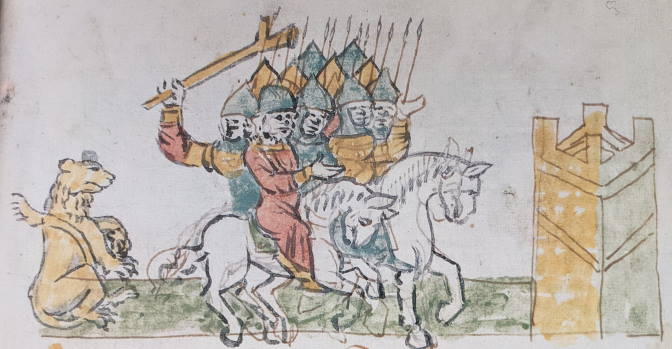
The sword, a common item during feudalism, appears in the Königsberg Chronicle several times in a symbolic role. In two cases, the surrender of a sword symbolizes the surrender of a city: when Kiev surrenders to Izyaslav Yaroslavich (folio 100 rev. bottom), and when Murom surrenders to the Volga Bulgars (folio 120 rev. top). In both cases, the sword is shown sheathed. The scabbard is painted yellow (gold).
Even more expressive are the scenes of investiture, which invariably depict a sword. Along with the legal analogies established by N.P. Pavlov-Sil’vansky in his comparison of Western European and Russian feudal relations, we can also add the rituals of Russian investiture preserved in the Königsberg Chronicle. They are seen three times. In all three cases, the prince sits on a throne in a princely hat, and a vassal stands before him. The first such scene is not terribly convincing. Here Vladimir Svyatoslavich, who sends Boris Vladimirovich to fight the Pechenegs, extends to him an unsheathed blue sword (folio 73 bottom). Since this image is not about a coronation, but rather about a military campaign, the sword retains its purely militaristic significance. Boris is also shown wearing a princely hat. The two subsequent scenes are more expressive. On one, Vladimir Vsevolodovich sends Andrey Vladimirovich to reign in Vladimir Volynsk, and extends to him a sword in a yellow (gold) scabbard. Andrey is shown without a hat (folio 157 rev. bottom). In the other, Vsevolod Ol’govich sends Svyatoslav Ol’govich to rule in Novgorod, and extends a bared, blue sword to him. Svyatoslav is depicted in some kind of a conical hat (folio 171 top). In all three cases, the ruler holds the sword by its blade with both hands, and the vassal extends both hands to receive it.
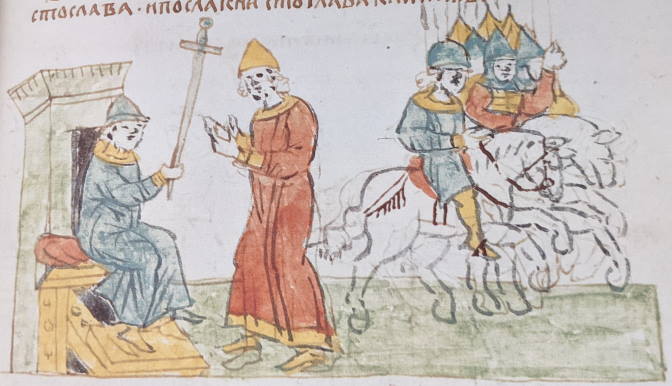
This entire feudal hierarchical system, militaristic symbolism and heraldry are all closely associated with the buyer’s ideology. But there is yet one more side to this ideology which we need to talk about specifically, which is the Church.
Bishops, even those who are not numbered among the saints, are almost always depicted with haloes. This symbol of holiness is here for these bishops also a symbol of their feudal rank, just like the princes’ hats. It is funny that even Chernigov’s Bishop Profiriy is shown in a halo, even though the text states about him: “those who twist their speech are not saintly, but rather subverters and liars,” and then, “Bishop Porfiriy was full of shame and dishonor.” On the other hand, we also see bishops without haloes, for example Luka Zhidyata (folio 86 rev. top), even though he was considered to be a saint. For princes who were sainted, namely Vladimir, Boris, Gleb, and Andrey, we see haloes over their princely hats — the first three sporadically, and Andrey only in the scene of his death.
In one case, the special “holiness” of Kiev, specifically as the residence of the Metropolitan, is emphasized. Over a fortress tower which represents the entire city, in this case Kiev, we see a ciborium or altar canopy (folio 167 rev. bottom).
The “holiness” and “miraculous” nature of the Vladimir icon is especially propagandized. It is depicted three times: its transportation to Vladimir (folio 200 rev. bottom), then on the field of battle with the Volga Bulgars (folio 205 rev;[84]jeb: see featured image at top of page. in the 12th-20th centuries, it was primarily a military icon), and finally in the scene of the “miraculous appearance” of the army of the city of Vladimir in heaven (folio 222 bottom; this is in general the only holy miracle shown in the Königsberg Chronicle, aside from a few instances of the Monastery of the Caves’ dealings with demons and the like). The precision of the icon’s depiction allows one to say that the illustrator must have seen in, either in the original or a copy. All of the details of Mary and Jesus’s pose and appearance match. The second illumination is particularly accurate. Mary is shown dressed in red, and Christ in yellow, both of which are accurate (this is also seen on the first illumination, while on the third they wear white). The background is yellow (gold). In the first two illuminations, the icon has a stand, a forked column. Only the proportions of the icon are somewhat inaccurate – the original icon is longer.
The relationship between church and state is shown with poster-like expressiveness in the miniature which illustrates the famous story about the death penalty imposed by Vladimir at the request of the bishops (folio 71). To the left is Vladimir, sitting on his throne in a princely hat and holding a sword. Before him, on a bench, are three bishops with Gospels under their arms. One of them didactically raises one hand to the sky. Heaven is seen in the form of a small, suspended, light-blue section (the common method of depiction at that time, seen in the Chronicle 10 times). To the right we see the immediate result of this ideological act. An executioner in a red shirt raises a heavy, unsheathed saber over the head of a bound and bent-over criminal.
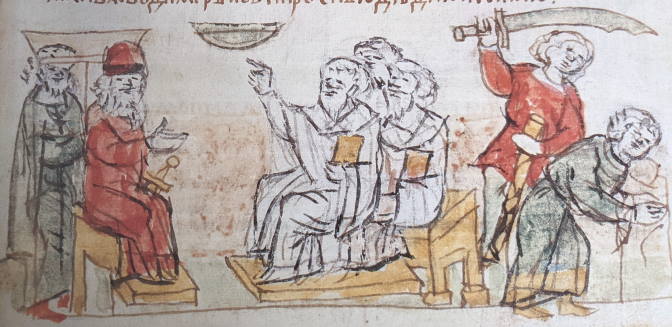
The Church itself was feudally organized. This is recalled by a scene of a religious investiture. Compositionally, it completely corresponds to the aforementioned worldly investiture, with a sword. Only here, the sword is replaced by a candle, which is thick and yellow, with a red flame. This scene shows Antoniy ordaining Varlaam as an abbot (folio 91 rev.).
Part VII – Antifeudal Displays of Power
The buyer’s feudal ideology did not match that of the illustrators themselves. This is quite clearly apparent from the illustrations belonging to the second artist. The first artisan, as a person of less-vivid personality, conveyed his own tastes less. Artisans were both craftsmen and citizens. It isn’t surprising that political tastes and inclinations characteristic of the urban craftsman class, which found particularly clear expression in Novgorod, should appear in their illustrations.
These inclinations were also familiar to some of the book’s readers. At least one of them, in 1528 (date established by A.A. Shakhmatov[85]Shakhmatov, Opisanie rukopisi…, pp. 7-8.) wrote in a corresponding location in the margins of folio 210: “Novgorodian Freedom.” Next to the words “From the very beginning, the Novgorodians gathered the Smolyans and the Kiyans and the Polotsk and all authorities to converge, like a parliament, for the Veche”, the same reader wrote on the margins of folio 220 (rev.) “see” and below that, “they’ve been good a long time.”
Uprisings of peasants and citizens against feudal exploitation are depicted repeatedly in the Chronicle. The illustrator was less interested in peasant uprisings, as this was not his class. The murder of Igor’ by the Drevlyans was interpreted (partially correctly) as an assassination by soldiers directed by the Drevlyan prince Mal (folio 27 rev.). But, we do see illustrated the history of the Beloozero uprising of starving peasants, led by sorcerers and pagan slogans, and which was put down by Jan Vyshatich. Scenes of battle in the woods are especially characteristic for peasant uprisings. The peasant in a short caftan, armed with a simple working axe, deliberately and sharply contrasts against the long-robed feudal lord Jan with an unsheathed saber. To the right, captive peasants are tied to the trees (folio 103). This is followed by scenes of pacification, at first by whipping the peasants (folio 104 top), and then by beheading them with sabers (folio 104 bottom).
Both artisans depict scenes of urban uprisings with special attention and interest. The ferocity with which the Poles beat the bishops, priests and boyars (folio 85 rev. top), or the Kievans chase out Izyaslav Yaroslavich (folio 99) is depicted fervently. In the scene of the uprising in Vladimir Volynsk (folio 145 top), we see the swiftness of the attack. As many as four miniatures are dedicated to the Kievan uprising which ended with the murder of Igor’ Ol’govich (folios 178 rev. top, 178 rev. bottom, 179, 179 rev. top); here, the bitterness of the mob is exceptionally vividly portrayed, as are Vladimir Mstislavich’s unsuccessful attempts to persuade the rioters to show Igor’ mercy. In the end, Igor’s half-naked corpse is dragged through the streets by two citizens in short shirts, who have tied a rope to his feet. Even more expressive is the depiction of the uprising of the citizens of the city of Bogolyubov. The rioters plundered the court of the murdered Andrey Yur’evich and beat up his courtiers (folio 215 rev.), who lie here on the ground in a formless, helpless mound. One of the citizens strips them naked, while the others hack at them with sabers.
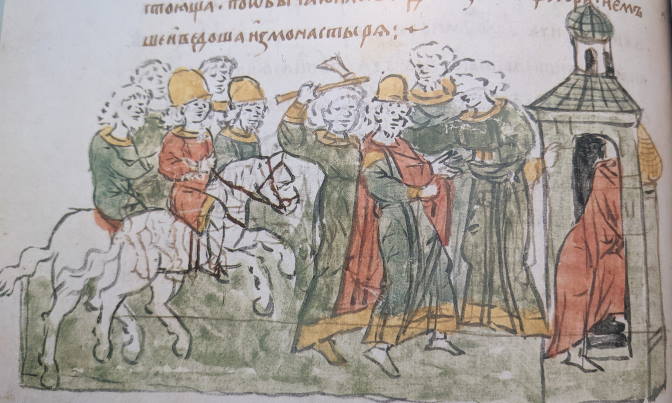
A different manifestation of the urbanites’ ideology appears in the humorous ridicule of feudal lords which appears in many of the illuminations. Sometimes this mockery attains the sharpness of political caricature. Let’s look at a few examples.
The Novgorodians hack apart the boats which Yaroslav Vladimirovich had planned to use to flee overseas (folio 81 rev. top). An imposing, bearded Novgorodian has walked right up to Yaroslav and clearly scolds him, pointing a finger straight into Yaroslav’s face, such that the prince leans backwards away from it. Yaroslav is seated on a throne, wearing his princely hat.

The Novgorodians are negotiating with Andrey Yur’evich on the selection of who will be prince (folio 204). This is one of the templates of an outstanding artist, who appears to have been the second artisan (his other masterpiece, folio 196 top, is thematically uninteresting). To the left stand the two candidates proposed by Andrey. Mstislav Yur’evich (bearded, in a princely hat) is rejected by the Novgorodians. The young Mstislav Rostislavich (without hat or beard) clenches his hands as they talk about him. In the center stands a large, pink throne. Andrey is seated upon it (bearded, with a princely hat); with a broad, merchantlike gesture, he indicates the candidates while he himself looks at the Novgorodians. There are three Novgorodians standing near the Grand Prince in hats (a Novgorodian privilege). The one on the left, with a large beard, speaks gravely with Andrey. The one in the middle, with a goatee, whispers something to the one on the right. The one on the right, almost without beard and thick-lipped, having gotten a taste of the negotiations, leans backward and grasps his hat.
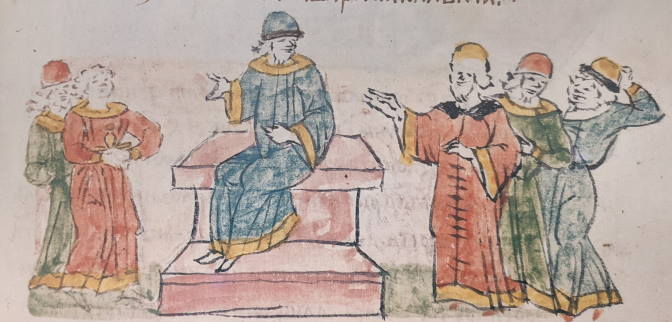
The Novgorodians once again select a new prince before the same Andrey (folio 212 bottom). They once again stand in hats before the prince. This time, they have gotten the Grand Prince’s son, Yuri Andreevich, and drag him away like a bundle by the arm.
Roman Mstislavich (folio 237 rev. top) expels Ryurik Rostislavich from Kiev. Here, in a single miniature, we see three comical scenes. Ryurik, who kisses Roman’s cross, jumps up and down, somehow conveying his reluctance to do so. The bishop extends with cross with a gesture as if he were about to hit Ryurik in the teeth with it. Afterwards, Ryurik drinks from a horn as a sign of loyalty to Roman. Roman holds his arm and, bending over (he is much taller), instructs him. Finally Ryurik is seated on a horse, and some Kievan sends him off by shoving him in the back. There are many similar examples.

I have described above two scenes illustrating the selection of princes. This method of rule is juxtaposed to those described in the previous section (investiture, inheritance, military takeover). Let us also look at one additional method.
We see depicted a wide platform, with an equally-wide base. The entirety is pink and smooth. The effect is something like two steps of a wide staircase. Upon this platform, five Rostovians and Suzdalians are seated without hats, and among them sits Andrey Yur’evich in a princely hat. They are all on the same step, at the same level (folio 201 rev. bottom). The second master has used this unusual composition of rule to respond to the words of the text: “The Rostovians and Suzdalians thought about Andrey’s offer, and they all sat upon the throne in Rostov and Suzdal’.” In this manner, the illumination shows a system of rule by election which would not have been, in fact, suitable to a prince like Andrey.
These ideologies of the citizen-craftsmen encountered in the Chronicle, it seems to me, must be explained as Germanisms. Novgorod was a window into Europe. Wherever Novgorodian ideology has penetrated, there too you find Western influence. Of course, both artists, especially the second one, sometimes imitated Western miniatures and engravings, but this was due to the fact that these miniatures and engravings arose in Germany in a socially analogous, craftsman-urban setting. Power was held by the hands of feudal lords in Novgorod, but the craftsmen-citizens won back there several rights.[86]Artsikhovskij, A.V. “K istorii Novgoroda.” Istoricheskie zapiski, Vol. 2, Moscow, 1938.
Novgorod attracted the attention of our artisans. The first illustration in the Chronicle depicts its building and has a special title: “Novgorod the Great” (folio 3). The text does not actually contain the words “the Great.” I already wrote about the Novgorod ambassadors standing before Andrey Yur’evich in hats (folios 204, 212 bottom). V.I. Sizov noted other sets of Novgorodian ambassadors who are even seated before the prince in hats.[87]Sizov, op. cit., pp. 26-27.. These depict negotiations with Vsevolod Ol’govich (folio 171 bottom), Svyatopolk Mstislavich (folio 171 rev. top), and Yuri Vladimirovich (folio 171 rev. bottom). We could also point out the Novgorodian ambassadors who sit, although without hats, before Svyatopolk Izyaslavich (folio 148 rev. bottom).

An important item of Novgorodian regalia was the archbishop’s white cowl. Even this is seen on the pages of the Königsberg Chronicle, where the Novgorodian lord is shown in his white cowl (folio 171 rev. top). Even more important is the depiction of another item of Novgorodian regalia. The mayor’s staff was a republican emblem of Novgorod, as is evident from P.L. Gusev’s research.[88]Gusev, Petr. “Simvoly vlasti v Velikom Novgorode, III, Posokh-kostyl’.” Vestnik arkheologii i istorii. Iss. III, 1911. The staff was long and straight, with a perpendicular, symmetrical pommel which gave it a T-shape. This staff, when placed upon a step known as the “veche step” (this is the origin of the expression “the staid mayor” [Rus. степенный посадник, stepennyj posadnik]) held special meaning. This combination symbolized the aristocratic republic, and was displayed on seals, and later on the Novgorod coat of arms. It is preserved on a 15th century seal from the collection of M.V. Tolstoy, bearing the inscription: “The Seal of the Lord of Novgorod the Great,”[89]idem., pp. 121-122. as well as in the 16th century Novgorod coat of arms (for example, seen on Ivan the Terrible’s seal), and in the 17th century (for example, on Mikhail Fedorovich’s throne). On the coat of arms, the staff is supported by a pair of bears. In the 17th century, the coat of arms changed in a way that, it seems to me, had clearly political, demonstrative meaning. The bears and the overall composition remain, but the Veche step is replaced by a throne, and the ruler’s staff is replaced by a scepter. The coat of arms thus received a directly contradictory meaning, and was preserved in this form until the 20th century.
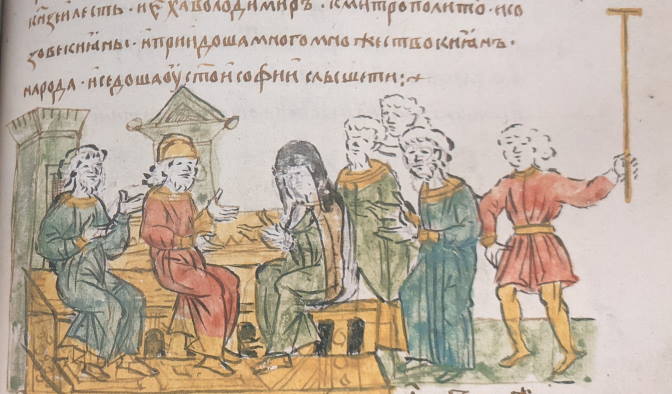
The Königsberg Chronicle depicts one scene of the Veche, although it is in Kiev rather than Novgorod (folio 178). But, in the 15th century, the Veche was understood to be a specifically Novgorodian thing. The illumination primarily belongs to the first artisan, and at first contained nothing specific to the Veche. But, the second artisan painted in the margin a young man to the right, in a short red shirt, who raises on high the ruler’s staff with his left hand. This staff is typical of the Novgorod kind, long and T-shaped. The staff is painted yellow, with a black streak. The staff was painted here intentionally as an emblem of the Veche.
List of Illustrations
- Folio 3: The construction of Novgorod by the Il’men Slavs.
- Folio 5: Various peoples offer tribute to the Rus’.
- Folio 5 rev. top: The reign of the Byzantine Emperor Heraklion.
- Folio 7: Construction and plowing the land, carried out by the women of the (Scythian) Gili tribe.
- Folio 27 rev.: Prince Igor’ is killed by the Derevlyans at Prince Mal’s order in the city of Iskorosten.
- Folio 29 bottom: Olga weeps at Igor’s grave; at her order, a large burial mound is built over his grave.
- Folio 44 rev.: Vladimir Svyatoslavich receives a legate of hired Varangians and distributes cities for them to rule; the other Varangian troops depart for Constantinople.
- Folio 45: The coronation of Vladimir Svyatoslavich in Kiev; at his order, wooden images of the god Perun and other pagan gods are erected on a hill.
- Folio 46 top: Vladimir Svyatoslavich negotiates tribute with the Vyatichi.
- Folio 46 bottom: Vladimir Svyatoslavich’s second campaign against the Vyatichi.
- Folio 71: Vladimir Svyatoslavich meets with the bishops and city elders about the punishment of robbers; the execution of a robber at Vladimir’s order.
- Folio 73 top: Vladimir Svyatoslavich’s letter to Yaroslav Vladimirovich of Novgorod, requiring them to pay Kiev 2000 hryvnia in taxes; Yaroslav’s refusal to pay.
- Folio 73 bottom: Vladimir Svyatoslavich presents a sword to his son, Boris Vladimirovich, for his fight against the Pechenegs.
- Folio 81 rev. top: The Novgorodians ask Yaroslav to continue his fight against Boleslav and Svyatopolk Vladimirovich; the Novgorodians hack apart Yaroslav Vladimirovich’s boats, to prevent him from fleeing overseas.
- Folio 97 rev. top: Vseslav Bryachislavich of Polotsk crosses the Dniepr in a boat; Vseslav and his two sons are captured and imprisoned.
- Folio 103: Jan Vyshatich and his youths defeat the peasants who joined the wizard-sorcerers in the forest near Beloozero.
- Folio 106 top: Gleb Svyatoslavich of Novgorod arrives to converse with the wizard; Gleb kills the wizard.
- Folio 110 rev.: Elder Matthew the Seer’s vision of evil spirits – a crowd of demons, led by one who rides a pig.
- Folio 117 top: Izyaslav Yaroslavich of Kiev’s death in battle near the village of Nezhatina Niva from a spear to the back. Oleg Svyatoslavich flees to Tmutarakan.
- Folio 118 rev.: Yaropolk Izyaslavich of Volynsk and his squad campaign against Vsevolod Yaroslavich of Kiev and Vladimir Vsevolodovich Monomakh (of Chernigov); Yaropolk flees to Poland.
- Folio 124 rev.: The drought of 1092, caused by full sun and lack of rain.
- Folio 133 rev.: The burial of the Polovtsian prince Tugorkan, father-in-law of Svyatopolk Izyaslavich of Kiev, in Berestovo.
- Folio 147: The armistice between Svyatopolk Izyaslavich of Kiev, Vladimir Vsevolodovich Monomakh (of Pereslavsky), David Svyatoslavich of Chernigov, and Oleg Svyatoslavich of Murom, at a meeting in Uvetichi.
- Folio 148 rev. top: Yaroslav Yaropolkovich Beresteysky, having fled Kiev, is captured by Yaroslav Svyatopolkovich of Volynsk; Yaroslav Yaropolkovich is clapped in irons at the court of Svyatopolk Izyaslavich of Kiev.
- Folio 158 top: Yuri Vladimirovich Dolgorukiy of Rostov’s campaign against the Volga Bulgars and his victory over them.
- Folio 158 bottom: The flight of the Turks and Berendei from Russian lands.
- Folio 165 top: The entry of Yaropolk Vladimirovich of Kiev’s troops into Pereyaslavl, which had been held for 8 days by Yuri Vladimirovich Dolgoruky of Rostov.
- Folio 171 top: Vsevolod Ol’govich of Kiev presents a sword as a sign of princely power to Svyatoslav Ol’govich; Svyatoslav departs to rule Novgorod.
- Folio 171 rev. top: Vsevolod Ol’govich of Kiev meets with his brothers-in-law; the arrest of the Novgorod embassy.
- Folio 178: Vladimir Mstislavich Gorodetsky meets with Metropolitan Kliment and residents of Kiev about the treason of the Chernigov princes.
- Folio 178 rev. bottom: Vladimir Mstislavich Gorodetsky attempts to outrun the rebellious residents to prevent bloodshed; the Kievans seize the prince-monk Igor’ Ol’govich in church; Igor leaves the monastery.
- Folio 191 rev. top: The opposing armies of Yuri Vladimirovich Dolgoruky and Izyaslav Mstislavich of Kiev before the Battle of the Rute River.
- Folio 193 rev. top: Hungarian King Géza II meets with Mstislav Izyaslavovich Pereyaslavsky and his allies; Vladimir’s escape from Ugric regiments.
- Folio 199 rev. top: The Kievan embassy, led by Bishop Demyan, to Izyaslav Davydovich of Chernigov (and Gleb Yurevich), and their invitation to Izyaslav to the Kievan throne.
- Folio 201 rev. bottom: Andrey Yur’evich Bogolyubsky’s rule on the throne of Rostov-Suzdal’.
- Folio 204: The Novgorodian ambassadors meet with Andrey Yur’evich Bogolyubsky (of Rostov) to request a prince, and the selection of a prince from the candidates Andrey has provided – Mstislav Yur’evich and Mstislav Rostislavich.
- Folio 205 rev.:[90]jeb: see featured image at top of page. A prayer of thanks to the Icon of the Blessed Mother of Vladimir, seized by Andrey Yur’evich Bogolyubsky in a campaign against the Volga Bulgars.
- Folio 207 rev. bottom: Kievan people and animals are seized by Polovtsian raiders and taken to the steppe.
- Folio 209 rev.: The Siege of Novgorod the Great by the army of the city of Vladimir, led by Mstislav Andreevich.
- Folio 212 top: Roman Rostislavich of Smolensk’s reign on the Kievan throne.
- Folio 217: Ambassadors from Suzdal’ invite Yaropolk Rostislavich to be prince of Chernigov.
- Folio 217 rev. bottom: The city of Vladimir is besieged by troops from Rostov-Suzdal’, led by Yaropolk Rostislavich.
- Folio 222 top: The boyars of Rostov invite Mstislav Rostislavich of Novgorod to be prince of Rostov.
- Folio 227 rev. bottom: Peace is attained, and Vsevolod Yur’evich gives land grants to the princes of Ryazan’.
- Folio 237 rev. top: Ryurik Rostislavich of Kiev kisses the cross; Ryurik (?) and Roman Mstislavich discuss the Kievan throne; Ryurik departs for Ovruch.
- Folio 242 rev.: Vsevolod Yurievich of Vladimir’s campaign against the Polovtsians; the Polovtsians flee, having heard about the Vladimir army’s movements.
- Folio 245 rev.: Ryurik Rostislavich of Kiev is captured by Roman Mstislavich of Galitsko-Volynsk, and is tonsured into the monastery; Roman captures Ryurik’s family.
Footnotes
| ↟1 | Shakhmatov, A.A. “Opisanie rukopisi, Stat’ja, prilozhennaja k fototipicheskomu izdaniju.” Radzivilovskaja, ili Kenigsbergskaja, letopis. Vol II. 1902. |
|---|---|
| ↟2 | Sreznevskij, I.I. Drevnie izobrazhenija velikogo knjazja Vladimira i velikoj knjagini Ol’gi.” Moscow, 1868. |
| ↟3 | Kondakov, N.P. “Zametka o miniatjurakh Kenigsbergskogo spiska nachal’noj letopisi.” Radzivilovskaja, ili Kenigsbergskaja, letopis. Vol II. 1902. |
| ↟4 | Kondakov, op. cit., p. 117. |
| ↟5 | Kondakov, op. cit., p. 117. |
| ↟6 | Kondakov, op. cit., p. 121. |
| ↟7 | Kondakov, op. cit., p. 123. |
| ↟8 | Sizov, V.I. “Miniatjury Kenigsbergskoj letopisi (Arkheologicheskij etjud).” Izv. Otd’nija rus. jazyka i slovesnosti Imp. Akademii nauk. 1905 (10), pp. 1-50. |
| ↟9 | Sizov, op. cit., p. 50. |
| ↟10 | Sizov, op. cit., p. 42. |
| ↟11 | jeb: Rus. елмань, elman’, a widening in the last third of a saber blade, common in Turkish and Eastern European medieval swords. |
| ↟12 | Sizov, op. cit., pp. 40-41. |
| ↟13 | Sizov, op. cit., pp. 28-29. |
| ↟14 | Polnoe sobranie russkikh letopisej [PSRL]. Vol. IV, p. 275. |
| ↟15 | Opis’ Moskovskoj oruzhejnoj palaty. Moscow, 1885, table 358, nos. 5224, 5233. |
| ↟16 | Lents. Opis’ sobranija oruzhija Sheremeteva. St. Petersburg, 1895, table X, illus. 377-378. |
| ↟17 | Sizov, op. cit., p. 43. |
| ↟18 | Sizov, op. cit., pp. 43-44. |
| ↟19 | See, for example, Materialy po arkheologii Rossii, No. 18, XIII, 3. |
| ↟20 | Sizov, op. cit., p. 14. |
| ↟21 | Sizov, op. cit., pp. 38-39. |
| ↟22 | Sizov, op. cit., plate 1, illus. 5. |
| ↟23 | Sizov, op. cit., p. 29. |
| ↟24 | Sizov, op. cit., p. 28. |
| ↟25 | Sizov, op. cit., p. 19. |
| ↟26 | Sizov, op. cit., p. 1. |
| ↟27 | Ajnalov, D.V. “Ocherki i zametki po istorii drevnerusskogo iskusstva. III: O nekotorykh serijakh miniatjur Radzivillovskoj letopisi.” Izvestija otd. russk. jaz. i slov. Akad. nauk. Vol. XIII, book 9, 1908. |
| ↟28 | Artamonov, M.I. “Miniatjury Kenigsbergskogo spiska letopisi.” Izvestija GAIMK. Vol. 10, Issue I. Leningrad, 1931. |
| ↟29 | Karinskij, N.M. Obraztsy pis’ma drevnejshego perioda istorii russkoj knigi. Leningrad, 1925, p. 10. |
| ↟30 | Artamonov, op. cit., p. 3. |
| ↟31 | Artamonov, op. cit., p. 15. |
| ↟32 | Shakhmatov, A.A. “Zametka o meste sostavlenija Radzivillovskogo (Kenigsbergskogo) spiska letopisi.” Sbornik v chest’ D.N. Anuchina. Moscow, 1913. |
| ↟33 | Shakhmatov, Opisanie rukopisi…, pp. 4-5. |
| ↟34 | Artamonov, op. cit., pp. 14-15. |
| ↟35 | Artamonov, op. cit., pp. 11-12. |
| ↟36 | Shakhmatov, A.A. “Issledovanie o Radzivillovskoj ili Kenigsbergskoj letopisi.” Izd. Obsch. ljubit. drevn. pis’m. CXVIII, vol. II, 1902, pp. 26-30. |
| ↟37 | Kondakov, op. cit., p. 123. |
| ↟38 | Sizov, op. cit., p. 45. |
| ↟39 | Il’in, A.A. Topografija kladov serebrjanykh i zolotykh slitkov. Petrograd, 1921, pp. 7-8. |
| ↟40 | Petersen. “De norske vikingesverd.” Kiristiania. 1919. Illus. 90, 91, 93. |
| ↟41 | Petersen, op. cit., p. 128. |
| ↟42 | Samokvasov, D.Ja. Mogil’nye drevnosti Chernigovschiny, Posmertnoe izdanie. Moscow, 1917, illus. 25. |
| ↟43 | Petersen, op. cit., p. 122. |
| ↟44 | A tribe of East Slavs who inhabited the area around the Oka, Moskva, and Don rivers. |
| ↟45 | Sizov, op. cit., p. 44. |
| ↟46 | Ajnalov, op. cit., p. 321. |
| ↟47 | Ajnalov, op. cit., p. 322. |
| ↟48 | Sizov, op. cit., pp. 15-16. |
| ↟49 | Tatischev, V.N. Istorija Rossijskaja. Vol. 2. Moscow, 1773, p. 229. |
| ↟50 | Tatischev, op. cit., p. 281. |
| ↟51 | Tatischev, op. cit., p. 313. |
| ↟52 | Tatischev, V.N. Istorija Rossijskaja., Vol. 3. Moscow, 1774, p. 82. |
| ↟53 | Tatischev, op. cit., vol. 3, p. 103. |
| ↟54 | Shakhmatov, op. cit., p. 103. |
| ↟55 | Sizov, op. cit., pp. 23-24. |
| ↟56 | Sizov, op. cit., pp. 32-34. |
| ↟57 | Kondakov, op. cit., p. 117. |
| ↟58 | Schwietering, Julius. Zur Geschichte von Speer und Schwert im 12 Jahrhundert. Hamburg, 1912, illus. 14-17. |
| ↟59 | Lents, E. Ermitazh, Ukazatel’ otdelenija crednikh vekov. Chast’ I: Sobranie oruzhija. St. Petersburg, 1908, pp. 301-302, 305; Lents, Al’bom sobranija oruzhija…, plates XXI, XXXI. |
| ↟60 | Petersen, op. cit. |
| ↟61 | Sizov, op. cit., p. 19. |
| ↟62 | Demmin, Auguste. Guide des amateurs d’armes. Paris, 1879, p. 365. |
| ↟63 | Gorodtsov, V.A. “Opisanie kholodnogo oruzhija.” Otchet Ross. Istoricheskogo muzeja za 1906 g. Moscow, 1907, pp. 106-107, illus. 43. |
| ↟64 | Savvaitov, Pavel. Opisanie starinnykh russkikh utvarej. St. Petersburg, 1896, p. 112. |
| ↟65 | Sizov, op. cit., pp. 40-41. |
| ↟66 | See, for example, Izvestija Arkheologicheskoj komissii. No. 15, illus. 394; Materialy po arkheologii Rossii (MAR), No. 29, plate XXVI, no. 6. |
| ↟67 | Raudonikas, W. Die Normannen der Wikingerzeit und das Ladogagebiet. Stockholm, 1930, illus. 38. |
| ↟68 | jeb: Similar shovel reinforcement plates have since been found in Novgorod, see https://rezansky.com/the-blacksmithing-arts-of-novgorod-the-great/#Illustration62. |
| ↟69 | Materialy po arkheologii Rossii. No. 18, plate IX, nos. 8 and 9. |
| ↟70 | jeb: Both spring and articulated scissors have been found in Novgorod as early as the 10th century. See https://rezansky.com/the-blacksmithing-arts-of-novgorod-the-great. |
| ↟71 | Artsikhovskij, A.V. “Sotsiologicheskoe znachenie evoljutsii zemledel’cheskikh orudij.” Trudy sotsiologicheskoj sektsii RANION. Vol. 1. Moscow, 1927. |
| ↟72 | jeb: A few instances of medieval coulters were found in Novgorod about 10 years later, from as early as the 11th century. See https://rezansky.com/the-blacksmithing-arts-of-novgorod-the-great/#Illustration56. Coulters were blades that cut the turf ahead of the plow, making it easier for the plowshare to turn over the earth. |
| ↟73 | Sizov, op. cit., p. 15. |
| ↟74 | Nikitskij, A.I. Istorija ekonomicheskogo byta Velikogo Novgoroda. Moscow, 1892, pp. 166, 173, 276. |
| ↟75 | Polnoe sobranie russkikh letopisej. Vol. V, p. 43. |
| ↟76 | jeb: see featured image at top of page. |
| ↟77 | jeb: the word here, stol, means table, but in medieval Russian was equivalent to the word prestol, “throne”. |
| ↟78 | According to the Primary Russian Chronicle, these brothers founded the city of Kiev. |
| ↟79 | jeb: The Aleksandria was a medieval Russian translation of a pseudo-historical novel about Alexander the Great. |
| ↟80 | Kondakov, op. cit., p. 125. |
| ↟81 | Sizov, op. cit., p. 16. |
| ↟82 | Artamonov, op. cit., p. 24. |
| ↟83 | Sobolevskij, A.I. Mednye vrata, Russkaya ikona. Vol. I. St. Petersburg, 1914. |
| ↟84 | jeb: see featured image at top of page. |
| ↟85 | Shakhmatov, Opisanie rukopisi…, pp. 7-8. |
| ↟86 | Artsikhovskij, A.V. “K istorii Novgoroda.” Istoricheskie zapiski, Vol. 2, Moscow, 1938. |
| ↟87 | Sizov, op. cit., pp. 26-27. |
| ↟88 | Gusev, Petr. “Simvoly vlasti v Velikom Novgorode, III, Posokh-kostyl’.” Vestnik arkheologii i istorii. Iss. III, 1911. |
| ↟89 | idem., pp. 121-122. |
| ↟90 | jeb: see featured image at top of page. |

